1. Direction: Find out which part of the sentence has an error and select the appropriate option. If a sentence is free from error, select ‘No Error’.
He gave me two (A)/ important information (B)/ I had been waiting for (C)/ the previous two months (D)/ No Error (E)
A. A
B. B
C. C
D. D
E. No Error
Solution
The correct answer is Option 2.
Key Points
- The primary issue in the sentence is the incorrect plural form “informations.”
- The noun “information” is uncountable and should not be pluralized.
- The correct phrase should be “pieces of important information,” ensuring grammatical correctness and clarity.
- Thus, the error is located in part B of the sentence.
Therefore, the correct answer is B.
Correct Sentence: “He gave me two pieces of important information I had been waiting for the previous two months.”
Additional Information
No error – This would be the correct option if there were no mistakes in the sentence, but there is an error in part B.
A: “He gave me two” – This part of the sentence is grammatically correct and does not require any changes.
C: “I had been waiting for” – This part of the sentence is grammatically correct and does not require any changes.
D: “the previous two months” – This part of the sentence is grammatically correct and does not require any changes.
2. Direction: Find out which part of the sentence has an error and select the appropriate option. If a sentence is free from error, select ‘No Error’.
Ram is taller, smarter, and wiser (A)/ than me in the (B)/ whole class and (C)/ is also kind-hearted. (D)/ No error. (E)/
A. A
B. B
C. C
D. D
E. E
Solution
The correct answer is option 3 i.e., B.
Key Points
- The error lies in the wrong usage of the pronoun ‘me’ in Part B.
- ‘me’ should be replaced by ‘I’ because after ‘than’, the pronoun used should be in the same case as that of the pronoun /Noun used before ‘than’.
- Example: You are bigger than me.
- In the given sentence, ‘Ram’ – the noun before ‘than’ is in the Nominative case; hence, the pronoun after ‘than’ needs to be in the Nominative Case.
- Therefore, ‘I’ should be used instead of ‘me’.
Correct sentence: “Ram is taller, smarter, and wiser than I am in the whole class and is also kind-hearted.”
3. Directions: In the following sentence, some parts have error and some are correct. Find out which part has an error and mark it as your answer. If there is no error, mark ‘No error’ as your answer.
The maid (A)/ cleaned the (B)/ hotel’s room which had the most luxurious (C)/ furniture and beautiful curtains.(D)/ No error (E)
A. A
B. B
C. C
D. D
E. E
Solution
The correct Answer is Option 3.
Key Points
- This sentence is an example of Possessive Case of Nouns.
- If the possessor is a building, an object, or a piece of furniture, you don’t need to add an apostrophe to show possession.
- Since, a hotel is a building, apostrophe won’t be added.
Correct sentence: The maid cleaned the hotel room which had the most luxurious furniture and beautiful curtains.
Additional InformationThe possessive case shows ownership. With the addition of ’s (or sometimes just the apostrophe), a noun can change from a simple person, place, or thing to a person, place, or thing that owns something.
4. Directions: In the following question, some part of the sentence may have an error. Find out which part of the sentence has an error and select the appropriate option. If a sentence is free from errors, select option ‘No error’.
Davy took a year (A) out to see the world (B) and broad his (C) experience of life. (D) No error (E)
A. A
B. B
C. C
D. D
E. E
Solution
The correct answer is ‘C’ i.e. error lies in part C of the sentence.
Key Points
In part C of the sentence, the usage of ‘Broad’ is incorrect instead, use ‘Broaden’
- According to the rule of parallelism, Whenever the ‘verb/adjective/noun/adverb’ is joined with coordinate conjunction then use the same type of ‘Verb/adjective/noun/adverb’. In the case of ‘Verb’ if it is in the past tense then use the second form of the verb.
- Let’s see an example-
- The tribes emphasized collective survival, mutual aid, and responsibility for one another.
So the correct sentence is- Davy took a year out to see the world and broaden his experience of life.
5. Directions: In the following question, some part of the sentence may have an error. Find out which part of the sentence has an error and select the appropriate option. If a sentence is free from errors, select option ‘No error’.
He is talking to the /(A) manager about the /(B) losses as though nothing /(C) has happened. /(D) No error /(E)
A. A
B. B
C. C
D. D
E. E
Solution
The correct answer is ‘D’ i.e. error lies in part D of the sentence.
Key Points
In part D of the sentence, the usage of ‘has happened’ is incorrect instead, use ‘had happened’
- According to grammar, we use the past simple tense after ‘as if/as though’ to say that how something appears now does match with reality.
- It means ‘the action is performed in the past’
- Let’s see an example-
- They are acting as if nothing had happened. (The speaker knows something has happened.)
So the correct sentence is- He is talking to the manager about the losses as though nothing had happened.
6. Directions: Read the passage given below and answer the questions that follow by choosing the correct/most appropriate options:
Last week, the Drug Controller General of India cleared, under the provisions of ‘emergency use authorisation’, a new mRNA vaccine for COVID-19 developed by Pune-based Gennova Biopharmaceuticals, a pioneer in India in developing mRNA vaccines. The vaccine is meant to be particularly effective against the dominant Omicron variant. With the World Health Organization having officially declared the end of the COVID-19 pandemic, there is no longer obsessive public interest in new variants. Even less so in newer vaccines. Data suggest that the uptake of the booster, or ‘precautionary doses’ of the array of COVID vaccines available in India has been declining for several months. Therefore, the significance of the new vaccine, GEMCOVAC-OM, is that it shows that an Indian company has the capability to make an mRNA vaccine, believed to be amenable to rapid production and scale-up, that could be useful against any future virus.
Normally, vaccines must go through progressive stages of testing, from Petri dishes to animals and expanding cohorts of human test subjects. Doing greater harm than good, or being unable to be better than the alternative in any of these stages is a ground for disqualification. This is why vaccine development and approvals are a decades-long enterprise.
During COVID-19, this risk-averse strategy was deemed unsuitable for the crisis at hand because of which drug regulators globally allowed vaccine makers to combine multiple stages while evaluating the efficacy, thus giving greater leeway to experimental formulations. This underlines the basic framework of ‘emergency use authorizations (EUA)’ adopted by regulators globally. Unlike the U.S. Food and Drug Administration (FDA) which has for many years been evaluating novel drug and vaccine candidates, India’s regulatory system has largely been geared toward evaluating formulations that have been approved abroad and in assessing their suitability to India. Mistrust, arbitrary decree, and lax regulations have historically plagued clinical trials in India. More than evidence-based assessment, it was a technicality in India’s ‘New Drugs and Clinical Trials Rules, 2019’ that allowed EUA in India for COVID-19 vaccines. A credible regime of phased, clinical trials and independent regulation for new drugs is still in its infancy in India. The FDA still authorises updated COVID-19 vaccines under emergency use provisions because while the pandemic is over, COVID-19 is not and thousands continue to die globally. This alone, however, cannot be the basis for continuing with the EUA regime in India. While the flexibility to accelerate should always be present, India must specify a streamlined regulatory process that weeds out non-essential steps but is hawk-eyed on safety and adverse reactions from new drugs and vaccines.
Question:
According to the passage, why was the emergency use authorization granted for the GEMCOVAC-OM vaccine?
A. It was developed by a renowned Indian pharmaceutical company.
B. It is effective against the Omicron variant of COVID-19.
C. The World Health Organization recommended its approval.
D. The uptake of booster doses of existing vaccines has been declining.
E. It underwent extensive testing stages and showed promising results.
Solution
Correct Answer: b) It is effective against the Omicron variant of COVID-19.
Key Points
Therefore, option b) is the correct answer.
The passage states that the GEMCOVAC-OM vaccine developed by Gennova Biopharmaceuticals has been cleared for emergency use authorization by the Drug Controller General of India. It further mentions that the vaccine is specifically designed to be effective against the dominant Omicron variant of COVID-19.
7. Directions: Read the passage given below and answer the questions that follow by choosing the correct/most appropriate options:
Last week, the Drug Controller General of India cleared, under the provisions of ‘emergency use authorisation’, a new mRNA vaccine for COVID-19 developed by Pune-based Gennova Biopharmaceuticals, a pioneer in India in developing mRNA vaccines. The vaccine is meant to be particularly effective against the dominant Omicron variant. With the World Health Organization having officially declared the end of the COVID-19 pandemic, there is no longer obsessive public interest in new variants. Even less so in newer vaccines. Data suggest that the uptake of the booster, or ‘precautionary doses’ of the array of COVID vaccines available in India has been declining for several months. Therefore, the significance of the new vaccine, GEMCOVAC-OM, is that it shows that an Indian company has the capability to make an mRNA vaccine, believed to be amenable to rapid production and scale-up, that could be useful against any future virus.
Normally, vaccines must go through progressive stages of testing, from Petri dishes to animals and expanding cohorts of human test subjects. Doing greater harm than good, or being unable to be better than the alternative in any of these stages is a ground for disqualification. This is why vaccine development and approvals are a decades-long enterprise.
During COVID-19, this risk-averse strategy was deemed unsuitable for the crisis at hand because of which drug regulators globally allowed vaccine makers to combine multiple stages while evaluating the efficacy, thus giving greater leeway to experimental formulations. This underlines the basic framework of ‘emergency use authorizations (EUA)’ adopted by regulators globally. Unlike the U.S. Food and Drug Administration (FDA) which has for many years been evaluating novel drug and vaccine candidates, India’s regulatory system has largely been geared toward evaluating formulations that have been approved abroad and in assessing their suitability to India. Mistrust, arbitrary decree, and lax regulations have historically plagued clinical trials in India. More than evidence-based assessment, it was a technicality in India’s ‘New Drugs and Clinical Trials Rules, 2019’ that allowed EUA in India for COVID-19 vaccines. A credible regime of phased, clinical trials and independent regulation for new drugs is still in its infancy in India. The FDA still authorises updated COVID-19 vaccines under emergency use provisions because while the pandemic is over, COVID-19 is not and thousands continue to die globally. This alone, however, cannot be the basis for continuing with the EUA regime in India. While the flexibility to accelerate should always be present, India must specify a streamlined regulatory process that weeds out non-essential steps but is hawk-eyed on safety and adverse reactions from new drugs and vaccines.
Question:
What is the significance of the emergency use authorizations (EUA) during the COVID-19 pandemic?
A. They allowed vaccine makers to bypass testing stages for faster approvals.
B. They ensured that vaccines were thoroughly tested and safe for use.
C. They gave leeway to experimental formulations and novel drugs.
D. They were adopted by regulators globally to evaluate vaccine candidates.
E. They facilitated rapid production and scale-up of mRNA vaccines.
Solution
Correct Answer: c) They gave leeway to experimental formulations and novel drugs.
Key Points
Hence, option c) is the correct answer.
The passage explains that the COVID-19 pandemic necessitated a departure from the usual progressive stages of vaccine testing. During this crisis, regulators globally, including in India, allowed vaccine makers to combine multiple stages of testing while evaluating efficacy.
This flexibility provided leeway for experimental formulations and novel drugs to be authorized for emergency use.
8. Directions: Read the passage given below and answer the questions that follow by choosing the correct/most appropriate options:
Last week, the Drug Controller General of India cleared, under the provisions of ‘emergency use authorisation’, a new mRNA vaccine for COVID-19 developed by Pune-based Gennova Biopharmaceuticals, a pioneer in India in developing mRNA vaccines. The vaccine is meant to be particularly effective against the dominant Omicron variant. With the World Health Organization having officially declared the end of the COVID-19 pandemic, there is no longer obsessive public interest in new variants. Even less so in newer vaccines. Data suggest that the uptake of the booster, or ‘precautionary doses’ of the array of COVID vaccines available in India has been declining for several months. Therefore, the significance of the new vaccine, GEMCOVAC-OM, is that it shows that an Indian company has the capability to make an mRNA vaccine, believed to be amenable to rapid production and scale-up, that could be useful against any future virus.
Normally, vaccines must go through progressive stages of testing, from Petri dishes to animals and expanding cohorts of human test subjects. Doing greater harm than good, or being unable to be better than the alternative in any of these stages is a ground for disqualification. This is why vaccine development and approvals are a decades-long enterprise.
During COVID-19, this risk-averse strategy was deemed unsuitable for the crisis at hand because of which drug regulators globally allowed vaccine makers to combine multiple stages while evaluating the efficacy, thus giving greater leeway to experimental formulations. This underlines the basic framework of ‘emergency use authorizations (EUA)’ adopted by regulators globally. Unlike the U.S. Food and Drug Administration (FDA) which has for many years been evaluating novel drug and vaccine candidates, India’s regulatory system has largely been geared toward evaluating formulations that have been approved abroad and in assessing their suitability to India. Mistrust, arbitrary decree, and lax regulations have historically plagued clinical trials in India. More than evidence-based assessment, it was a technicality in India’s ‘New Drugs and Clinical Trials Rules, 2019’ that allowed EUA in India for COVID-19 vaccines. A credible regime of phased, clinical trials and independent regulation for new drugs is still in its infancy in India. The FDA still authorises updated COVID-19 vaccines under emergency use provisions because while the pandemic is over, COVID-19 is not and thousands continue to die globally. This alone, however, cannot be the basis for continuing with the EUA regime in India. While the flexibility to accelerate should always be present, India must specify a streamlined regulatory process that weeds out non-essential steps but is hawk-eyed on safety and adverse reactions from new drugs and vaccines.
Question:
Why does the passage mention the mistrust, arbitrary decree, and lax regulations in clinical trials in India?
A. To highlight the challenges faced by Indian pharmaceutical companies.
B. To contrast India’s regulatory system with the U.S. Food and Drug Administration.
C. To emphasize the need for evidence-based assessment in clinical trials.
D. To explain the historical context of vaccine development in India.
E. To justify the adoption of emergency use authorizations in India.
Solution
Correct Answer: d) To explain the historical context of vaccine development in India.
Key Points
Hence, the reason the passage mentions mistrust, arbitrary decree, and lax regulations in clinical trials in India is primarily to explain the historical context of vaccine development in India – making option 4) the most accurate answer.
The paragraph in the passage that refers to “mistrust, arbitrary decree, and lax regulations” in India’s clinical trials provides historical context on how India’s regulatory system has operated in the past, emphasizing its shortcomings in governing clinical trials and evaluating new drugs and vaccines.
Here’s the relevant extract: “Mistrust, arbitrary decree, and lax regulations have historically plagued clinical trials in India. More than evidence-based assessment, it was a technicality in India’s ‘New Drugs and Clinical Trials Rules, 2019’ that allowed EUA in India for COVID-19 vaccines.”
In this context, the author is saying that historically, India’s approach to clinical trials has been marred by mistrust, arbitrary decisions, and relaxed regulations. These issues have deterred the evolution of a robust, evidence-based clinical trials environment in India, as has been seen in other countries like the U.S.
The author further points out that India has largely been dealing with formulations already approved abroad, instead of pioneering the development of new drugs and vaccines. The emphasis is on the need for a more stringent and credible regulatory environment in India.
Therefore, while the passage does draw a comparison with the U.S FDA, the purpose of mentioning these issues (“mistrust, arbitrary decree, and lax regulations”) is to provide a historical understanding of the challenges and shortcomings of vaccine development and regulation in India. It’s these historical aspects that have shaped India’s current approach to drug regulation and highlight the necessity for further reforms.
9. Directions: Read the passage given below and answer the questions that follow by choosing the correct/most appropriate options:
Last week, the Drug Controller General of India cleared, under the provisions of ‘emergency use authorisation’, a new mRNA vaccine for COVID-19 developed by Pune-based Gennova Biopharmaceuticals, a pioneer in India in developing mRNA vaccines. The vaccine is meant to be particularly effective against the dominant Omicron variant. With the World Health Organization having officially declared the end of the COVID-19 pandemic, there is no longer obsessive public interest in new variants. Even less so in newer vaccines. Data suggest that the uptake of the booster, or ‘precautionary doses’ of the array of COVID vaccines available in India has been declining for several months. Therefore, the significance of the new vaccine, GEMCOVAC-OM, is that it shows that an Indian company has the capability to make an mRNA vaccine, believed to be amenable to rapid production and scale-up, that could be useful against any future virus.
Normally, vaccines must go through progressive stages of testing, from Petri dishes to animals and expanding cohorts of human test subjects. Doing greater harm than good, or being unable to be better than the alternative in any of these stages is a ground for disqualification. This is why vaccine development and approvals are a decades-long enterprise.
During COVID-19, this risk-averse strategy was deemed unsuitable for the crisis at hand because of which drug regulators globally allowed vaccine makers to combine multiple stages while evaluating the efficacy, thus giving greater leeway to experimental formulations. This underlines the basic framework of ‘emergency use authorizations (EUA)’ adopted by regulators globally. Unlike the U.S. Food and Drug Administration (FDA) which has for many years been evaluating novel drug and vaccine candidates, India’s regulatory system has largely been geared toward evaluating formulations that have been approved abroad and in assessing their suitability to India. Mistrust, arbitrary decree, and lax regulations have historically plagued clinical trials in India. More than evidence-based assessment, it was a technicality in India’s ‘New Drugs and Clinical Trials Rules, 2019’ that allowed EUA in India for COVID-19 vaccines. A credible regime of phased, clinical trials and independent regulation for new drugs is still in its infancy in India. The FDA still authorises updated COVID-19 vaccines under emergency use provisions because while the pandemic is over, COVID-19 is not and thousands continue to die globally. This alone, however, cannot be the basis for continuing with the EUA regime in India. While the flexibility to accelerate should always be present, India must specify a streamlined regulatory process that weeds out non-essential steps but is hawk-eyed on safety and adverse reactions from new drugs and vaccines.
Question:
According to the passage, why does the FDA continue to authorize updated COVID-19 vaccines under emergency use provisions?
A. The pandemic is over, but COVID-19 cases and deaths continue globally.
B. The FDA has a long-standing practice of evaluating novel drug candidates.
C. The FDA has a streamlined regulatory process for vaccine approvals.
D. The FDA is more flexible in granting emergency use authorizations.
E. The FDA relies on evidence-based assessment for vaccine safety.
Solution
Correct Answer: a) The pandemic is over, but COVID-19 cases and deaths continue globally.
Key Points
Hence, option a) is the correct answer.
The passage states that while the World Health Organization has declared the end of the COVID-19 pandemic, the disease caused by the virus is still ongoing, and thousands of people continue to die globally.
Therefore, the FDA continues to authorize updated COVID-19 vaccines under emergency use provisions to address the ongoing impact of the disease.
10. Directions: Read the passage given below and answer the questions that follow by choosing the correct/most appropriate options:
Last week, the Drug Controller General of India cleared, under the provisions of ‘emergency use authorisation’, a new mRNA vaccine for COVID-19 developed by Pune-based Gennova Biopharmaceuticals, a pioneer in India in developing mRNA vaccines. The vaccine is meant to be particularly effective against the dominant Omicron variant. With the World Health Organization having officially declared the end of the COVID-19 pandemic, there is no longer obsessive public interest in new variants. Even less so in newer vaccines. Data suggest that the uptake of the booster, or ‘precautionary doses’ of the array of COVID vaccines available in India has been declining for several months. Therefore, the significance of the new vaccine, GEMCOVAC-OM, is that it shows that an Indian company has the capability to make an mRNA vaccine, believed to be amenable to rapid production and scale-up, that could be useful against any future virus.
Normally, vaccines must go through progressive stages of testing, from Petri dishes to animals and expanding cohorts of human test subjects. Doing greater harm than good, or being unable to be better than the alternative in any of these stages is a ground for disqualification. This is why vaccine development and approvals are a decades-long enterprise.
During COVID-19, this risk-averse strategy was deemed unsuitable for the crisis at hand because of which drug regulators globally allowed vaccine makers to combine multiple stages while evaluating the efficacy, thus giving greater leeway to experimental formulations. This underlines the basic framework of ‘emergency use authorizations (EUA)’ adopted by regulators globally. Unlike the U.S. Food and Drug Administration (FDA) which has for many years been evaluating novel drug and vaccine candidates, India’s regulatory system has largely been geared toward evaluating formulations that have been approved abroad and in assessing their suitability to India. Mistrust, arbitrary decree, and lax regulations have historically plagued clinical trials in India. More than evidence-based assessment, it was a technicality in India’s ‘New Drugs and Clinical Trials Rules, 2019’ that allowed EUA in India for COVID-19 vaccines. A credible regime of phased, clinical trials and independent regulation for new drugs is still in its infancy in India. The FDA still authorises updated COVID-19 vaccines under emergency use provisions because while the pandemic is over, COVID-19 is not and thousands continue to die globally. This alone, however, cannot be the basis for continuing with the EUA regime in India. While the flexibility to accelerate should always be present, India must specify a streamlined regulatory process that weeds out non-essential steps but is hawk-eyed on safety and adverse reactions from new drugs and vaccines.
Question:
What does the passage suggest about India’s regulatory process for new drugs and vaccines?
A. It is in its infancy and lacks a credible regime of phased clinical trials.
B. It has historically focused on evaluating approved formulations from abroad.
C. It is more stringent and safety-focused compared to the U.S. FDA.
D. It is based on arbitrary decrees and mistrust in clinical trials.
E. It requires vaccines to go through progressive testing stages like Petri dishes and animal trials.
Solution
Correct Answer: a) It is in its infancy and lacks a credible regime of phased clinical trials.
Key Points
Therefore, option a) is the correct answer.
The passage implies that India’s regulatory process for new drugs and vaccines is still in its infancy and lacks a credible regime of phased clinical trials. It mentions that the regulatory system has historically been geared towards evaluating formulations approved abroad and has faced issues such as mistrust, arbitrary decree, and lax regulations.
11. Directions: Read the passage given below and answer the questions that follow by choosing the correct/most appropriate options:
Last week, the Drug Controller General of India cleared, under the provisions of ‘emergency use authorisation’, a new mRNA vaccine for COVID-19 developed by Pune-based Gennova Biopharmaceuticals, a pioneer in India in developing mRNA vaccines. The vaccine is meant to be particularly effective against the dominant Omicron variant. With the World Health Organization having officially declared the end of the COVID-19 pandemic, there is no longer obsessive public interest in new variants. Even less so in newer vaccines. Data suggest that the uptake of the booster, or ‘precautionary doses’ of the array of COVID vaccines available in India has been declining for several months. Therefore, the significance of the new vaccine, GEMCOVAC-OM, is that it shows that an Indian company has the capability to make an mRNA vaccine, believed to be amenable to rapid production and scale-up, that could be useful against any future virus.
Normally, vaccines must go through progressive stages of testing, from Petri dishes to animals and expanding cohorts of human test subjects. Doing greater harm than good, or being unable to be better than the alternative in any of these stages is a ground for disqualification. This is why vaccine development and approvals are a decades-long enterprise.
During COVID-19, this risk-averse strategy was deemed unsuitable for the crisis at hand because of which drug regulators globally allowed vaccine makers to combine multiple stages while evaluating the efficacy, thus giving greater leeway to experimental formulations. This underlines the basic framework of ‘emergency use authorizations (EUA)’ adopted by regulators globally. Unlike the U.S. Food and Drug Administration (FDA) which has for many years been evaluating novel drug and vaccine candidates, India’s regulatory system has largely been geared toward evaluating formulations that have been approved abroad and in assessing their suitability to India. Mistrust, arbitrary decree, and lax regulations have historically plagued clinical trials in India. More than evidence-based assessment, it was a technicality in India’s ‘New Drugs and Clinical Trials Rules, 2019’ that allowed EUA in India for COVID-19 vaccines. A credible regime of phased, clinical trials and independent regulation for new drugs is still in its infancy in India. The FDA still authorises updated COVID-19 vaccines under emergency use provisions because while the pandemic is over, COVID-19 is not and thousands continue to die globally. This alone, however, cannot be the basis for continuing with the EUA regime in India. While the flexibility to accelerate should always be present, India must specify a streamlined regulatory process that weeds out non-essential steps but is hawk-eyed on safety and adverse reactions from new drugs and vaccines.
Question:
Which of the following words is a synonym for ‘declining‘ as used in the passage?
A. Decreasing
B. Increasing
C. Expanding
D. Surging
E. Escalating
Solution
The correct answer is ‘Decreasing.’
Key Points
- ‘Declining’ means decreasing or going down.
- The synonym for ‘declining’ is ‘decreasing’ because it shares the same meaning.
Additional Information
‘Escalating’ means intensifying or becoming more severe
Increasing’ means going up or becoming more.
‘Expanding’ means getting bigger or extending.
‘Surging’ means rising or increasing quickly.
12. Directions: Read the passage given below and answer the questions that follow by choosing the correct/most appropriate options:
Last week, the Drug Controller General of India cleared, under the provisions of ‘emergency use authorisation’, a new mRNA vaccine for COVID-19 developed by Pune-based Gennova Biopharmaceuticals, a pioneer in India in developing mRNA vaccines. The vaccine is meant to be particularly effective against the dominant Omicron variant. With the World Health Organization having officially declared the end of the COVID-19 pandemic, there is no longer obsessive public interest in new variants. Even less so in newer vaccines. Data suggest that the uptake of the booster, or ‘precautionary doses’ of the array of COVID vaccines available in India has been declining for several months. Therefore, the significance of the new vaccine, GEMCOVAC-OM, is that it shows that an Indian company has the capability to make an mRNA vaccine, believed to be amenable to rapid production and scale-up, that could be useful against any future virus.
Normally, vaccines must go through progressive stages of testing, from Petri dishes to animals and expanding cohorts of human test subjects. Doing greater harm than good, or being unable to be better than the alternative in any of these stages is a ground for disqualification. This is why vaccine development and approvals are a decades-long enterprise.
During COVID-19, this risk-averse strategy was deemed unsuitable for the crisis at hand because of which drug regulators globally allowed vaccine makers to combine multiple stages while evaluating the efficacy, thus giving greater leeway to experimental formulations. This underlines the basic framework of ‘emergency use authorizations (EUA)’ adopted by regulators globally. Unlike the U.S. Food and Drug Administration (FDA) which has for many years been evaluating novel drug and vaccine candidates, India’s regulatory system has largely been geared toward evaluating formulations that have been approved abroad and in assessing their suitability to India. Mistrust, arbitrary decree, and lax regulations have historically plagued clinical trials in India. More than evidence-based assessment, it was a technicality in India’s ‘New Drugs and Clinical Trials Rules, 2019’ that allowed EUA in India for COVID-19 vaccines. A credible regime of phased, clinical trials and independent regulation for new drugs is still in its infancy in India. The FDA still authorises updated COVID-19 vaccines under emergency use provisions because while the pandemic is over, COVID-19 is not and thousands continue to die globally. This alone, however, cannot be the basis for continuing with the EUA regime in India. While the flexibility to accelerate should always be present, India must specify a streamlined regulatory process that weeds out non-essential steps but is hawk-eyed on safety and adverse reactions from new drugs and vaccines.
Question:
Which of the following words is an antonym for ‘flexibility‘ as used in the passage?
A. Rigidity
B. Adaptability
C. Versatility
D. Resilience
E. Suppleness
Solution
The correct answer is ‘Rigidity.’
Key Points
- ‘Flexibility’ refers to the ability to adapt or bend easily.
- The antonym for ‘flexibility’ is ‘rigidity’ because it represents the opposite characteristic of being inflexible or stiff.
Additional Information
‘Suppleness’ means being flexible or bending easily.
‘Adaptability’ means the ability to adjust or change according to circumstances.
‘Versatility’ means having many different uses or abilities.
‘Resilience’ means the ability to bounce back or recover quickly.
13. Directions: Read the passage given below and answer the questions that follow by choosing the correct/most appropriate options:
Last week, the Drug Controller General of India cleared, under the provisions of ‘emergency use authorisation’, a new mRNA vaccine for COVID-19 developed by Pune-based Gennova Biopharmaceuticals, a pioneer in India in developing mRNA vaccines. The vaccine is meant to be particularly effective against the dominant Omicron variant. With the World Health Organization having officially declared the end of the COVID-19 pandemic, there is no longer obsessive public interest in new variants. Even less so in newer vaccines. Data suggest that the uptake of the booster, or ‘precautionary doses’ of the array of COVID vaccines available in India has been declining for several months. Therefore, the significance of the new vaccine, GEMCOVAC-OM, is that it shows that an Indian company has the capability to make an mRNA vaccine, believed to be amenable to rapid production and scale-up, that could be useful against any future virus.
Normally, vaccines must go through progressive stages of testing, from Petri dishes to animals and expanding cohorts of human test subjects. Doing greater harm than good, or being unable to be better than the alternative in any of these stages is a ground for disqualification. This is why vaccine development and approvals are a decades-long enterprise.
During COVID-19, this risk-averse strategy was deemed unsuitable for the crisis at hand because of which drug regulators globally allowed vaccine makers to combine multiple stages while evaluating the efficacy, thus giving greater leeway to experimental formulations. This underlines the basic framework of ‘emergency use authorizations (EUA)’ adopted by regulators globally. Unlike the U.S. Food and Drug Administration (FDA) which has for many years been evaluating novel drug and vaccine candidates, India’s regulatory system has largely been geared toward evaluating formulations that have been approved abroad and in assessing their suitability to India. Mistrust, arbitrary decree, and lax regulations have historically plagued clinical trials in India. More than evidence-based assessment, it was a technicality in India’s ‘New Drugs and Clinical Trials Rules, 2019’ that allowed EUA in India for COVID-19 vaccines. A credible regime of phased, clinical trials and independent regulation for new drugs is still in its infancy in India. The FDA still authorises updated COVID-19 vaccines under emergency use provisions because while the pandemic is over, COVID-19 is not and thousands continue to die globally. This alone, however, cannot be the basis for continuing with the EUA regime in India. While the flexibility to accelerate should always be present, India must specify a streamlined regulatory process that weeds out non-essential steps but is hawk-eyed on safety and adverse reactions from new drugs and vaccines.
Question:
Which of the following words is a synonym for ‘streamlined‘ as used in the passage?
A. Complicated
B. Elaborate
C. Simplified
D. Complex
E. Intricate
Solution
The correct answer is ‘Simplified.’
Key Points
- ‘Streamlined’ refers to something that has been made more efficient or simplified.
- The synonym for ‘streamlined’ is ‘simplified’ because it represents the same concept of making something more straightforward or efficient.
Additional Information
‘Intricate’ means complex or detailed.
‘Complicated’ means complex or difficult to understand.
‘ Elaborate’ means detailed or intricate.
‘Complex’ means having many interconnected parts or elements.
14. Below a word is given followed by three sentences which consist of that word. Identify the sentence/s which best expresses the meaning of the word. Choose option 5 (None of these) if the word is not suitable in any of the sentences.
Allowance
A. Windows have a chilling effect on a room, and in calculations extra allowance should be made for window areas.
B. They agreed to pay him an annual allowance of hundred florins while engaged upon the work.
C. Until he was about forty he seems to have enjoyed a very moderate allowance from his father, but in the latter part of his life he was left a fortune which made him one of the richest men of his time.
A. Both A and B
B. Both B and C
C. Both C and A
D. A, B, and C
E. None of these
Solution
The correct answer is option 4, as all three sentences use the word correctly.
Key Points
Among these, the meaning given in 1, makes statement A correct, the one given in 2, makes statement B and C correct.
The word allowance carries several meanings:
1. the amount of something that is permitted, especially within a set of regulations or for a specified purpose.
2. a sum of money paid regularly to a person to meet needs or expenses.
15. Below a word is given followed by three sentences which consist of that word. Identify the sentence/s which best expresses
the meaning of the word. Choose option 5 (None of these) if the word is not suitable in any of the sentences.
Freight
A. China’s biggest oil refiner is reportedly planning to cut output in response to those higher freight rates.
B. Halloween festivities come to a close this weekend and this is your last chance to enjoy freights, trick or treating, and spooky fun.
C. People in our neighborhood think that that orange and green office building is a hideous freight.
A. A
B. B
C. C
D. All A, B and C
E. None of these
Solution
The correct answer is option 1.
Key Points
Thus, option 1 is correct.
Freight means the compensation paid for the transportation of goods.
In A this is used correctly.
In B and C, it should be replaced by fright as it refers to ‘fear excited by sudden danger’.
16. Below a word is given followed by three sentences which consist of that word. Identify the sentence/s which best expresses
the meaning of the word. Choose option 5 (None of these) if the word is not suitable in any of the sentences.
Lone
A. In the new episode, Eddie offers to help Jamie pay off his student lone.
B. But China and Russia continue to be Venezuela’s most powerful international boosters and have bailed out Maduro by giving his government massive lone.
C. The Tigers have won 25 of their last 26 games dating back to last season, with the lone loss coming in the closing seconds of the Final Four against eventual-champion Virginia.
A. B
B. A
C. C
D. A and B
E. None of these
Solution
The correct answer is option 3.
Key Points
Thus, option 3 is correct.
Lone means solitary or singular.
It is used correctly in C as it refers to the only loss.
In A and B, it should be replaced with loan as it means money lent at interest.
17. In the following sentence, four words or phrases have been printed in bold. One bold part in the sentence is not acceptable in Standard English. Pick up that part and mark its number. If there are no errors in the bold parts, mark (5) i.e. No error as the answer.
The India – Australia 20-20 match turned to be route for India.
A. India
B. Australia
C. Match
D. Route
E. No Error
Solution
The correct answer is option 4.
Key Points
The misspelled word is ‘route’ in the provided sentence.
- The correct word would be ‘rout’.
- The word ‘rout‘ is a noun that means ‘a decisive defeat’. (पराजय)
- For Example –
- The team suffered a humiliating rout in the match.
Therefore, the correct answer is ‘route’.
Additional Information
Let’s understand the meanings of the other marked words –
Match – A noun referring to a sports contest.
India – A proper noun referring to the country.
Australia – A proper noun referring to the country.
18. In the following sentence, four words or phrases have been printed in bold. One bold part in the sentence is not acceptable in Standard English. Pick up that part and mark its number. If there are no errors in the bold parts, mark (5) i.e. No error as the answer.The party isn’t a favoured event of high society if the socialists don’t make an appearance.
A. Favoured
B. Society
C. Socialist
D. Appearance
E. No error
Solution
The correct answer is option 3.
Key Points
The incorrect word is ‘Socialist’.
- In the given sentence, the word ‘Socialist’ is incorrectly used in the context.
- Explanation: A ‘socialist’ is a person who supports or advocates socialism, which refers to a political and economic ideology. However, in the context of this sentence, the correct term should be ‘socialites’, which refers to individuals who are well-known in fashionable society and often attend social gatherings or events.
- For Example: The socialites were excited to attend the charity gala.
Therefore, the correct answer is ‘Socialist’.
Additional Information
Let’s understand the meanings of the other marked words:
Appearance – The act of appearing in public or becoming visible. (उपस्थिति)
Favoured – Preferred or regarded with special favor. (पसंदीदा)
Society – The aggregate of people living together in a more or less ordered community. (समाज)
19. In the following sentence, four words or phrases have been printed in bold. One bold part in the sentence is not acceptable in Standard English. Pick up that part and mark its number. If there are no errors in the bold parts, mark (5) i.e. No error as the answer.According to the fashion critic, the actress committed a major socialism when she wore white after Labor Day.
A. Fashion
B. Critic
C. Committed
D. Socialism
E. No Error
Solution
The correct answer is option 4.
Key Points
The incorrect word is ‘socialism’.
- The word ‘socialism’ is incorrect in this context.
- The correct word should be ‘social faux pas’ or ‘fashion faux pas’, which refers to a blunder in social or fashion etiquette.
- The word ‘socialism’ refers to a political and economic theory advocating for social ownership and democratic control of resources. It does not fit the intended meaning in this sentence.
Therefore, the correct answer would be ‘socialism’.
Additional Information
Let’s understand the meanings of the other marked words –
Committed – dedicated or pledged to a cause or activity (प्रतिबद्ध)
Fashion – the prevailing style in clothes, behavior, etc. (फैशन)
Critic – (आलोचक)
20. In the following sentence, four words or phrases have been printed in bold. One bold part in the sentence is not acceptable in Standard English. Pick up that part and mark its number. If there are no errors in the bold parts, mark (5) i.e. No error as the answer.The trekking experience was great and all the students were amused at the proper arrangement in that small village.
A. Trekking
B. Experience
C. Amused
D. Arrangement
E. No error
Solution
The correct answer is option 3.
Key Points
The word ‘amused’ is incorrectly used in the given context.
- ‘Amused’ means finding something funny or entertaining, which is inappropriate here.
- The correct word should be ‘amazed’, which means being greatly surprised or filled with wonder.
- Correct Sentence: The trekking experience was great and all the students were amazed at the proper arrangement in that small village.
Additional Information
Explanation of other bold words:
Arrangement: A plan or preparation made for an event (correct usage).
Trekking: The act of going on a long, adventurous journey on foot (correct usage).
Experience: The knowledge or skill acquired by engaging in an activity (correct usage).
21. Directions: Select the most appropriate word to fill in the blank.
The Lokpal files the case in court after the _______.
A. Provision
B. Investigation
C. Illusion
D. Character
E. Prevention
Solution
The correct answer is ‘Investigation.‘
Key Points
- The given sentence is talking about the procedure of filing a case by the Lokpal in court.
- Therefore, the most appropriate word to be filled in the blank is ‘Investigation’.
- The word ‘Investigation‘ means An official examination of the facts about a situation, crime, etc.
- Example: The police have eliminated two suspects from their investigation.
- Example: The police have eliminated two suspects from their investigation.
Hence, the correct answer is option 2.
Complete Sentence: The Lokpal files the case in court after the investigation.
Additional Information
Prevention means The action of stopping something from happening or arising.
Let us explore the other options:
Provision means The action of providing or supplying something for use.
Illusion means A false idea, belief, or impression.
Character means The mental and moral qualities distinctive to an individual.
22. Directions: The given question has one blank indicating that something has been omitted. Choose the word for the given options that could fit in the blank correctly.
She tried to _______ the building from panic.
A. Disturb
B. Interrupt
C. Distract
D. Divert
E. Denied
Solution
The correct answer is ‘Distract‘.
Key Points
- Distract: Draw someone’s attention away from something.
- Ex: The thief distracted the bystanders.
- As She tried to draw the building attention away from a panic situation, so distracts is the best option for the given blank.
- Hence, option 3 is the correct answer.
The correct sentence is: She tried to distract the building from panic.
Additional Information
Let’s understand the meaning of the other options:
Ex: both firms deny any responsibility for the tragedy.
Disturb: Destroy the peace or tranquillity of
Ex: Don’t disturb me when I’m reading.
Interrupt: Make a break-in.
Ex: We interrupt the program for the following messages.
Divert: Turn aside; turn away from.
Ex: These things divert you from your goal.
Denied: state that one refuses to admit the truth or existence of.
23. Directions: The given question has one blank indicating that something has been omitted. Choose the word for the given options that could fit in the blank correctly.
The deer ______ ran into the forest.
A. Quickly
B. Rapidly
C. Increasingly
D. Correctly
E. none of the above
Solution
The correct answer is ‘quickly’.
Key Points
- Here in the sentence, we need an adverb of manner to qualify the verb ‘ran’.
- Adverbs of manner tell us how something happens.
- The sentence indicates the sense of an increase in the speed of deer into the forest. Hence, quickly is the most appropriate choice among all.
- Hence, option 1 is the correct answer.
The correct answer: The deer quickly ran into the forest.
Additional Information
Adverbs of time
I’m going to tidy my room tomorrow.
Adverbs of time tell us when an action happened, but also for how long, and how often. Adverbs of time are invariable.
They are extremely common in English. Adverbs of time have standard positions in a sentence depending on what the adverb of time is telling us.
Goldilocks went to the Bears’ house yesterday.
24. Directions: Choose the word for the given options that could fit in the blank correctly.
I didn’t _______ you at first with your new haircut.
A. Celebrated
B. Recognize
C. Famous
D. Renown
E. Condemned
Solution
The correct answer is Recognize
Key Points
- Here in the blank, we need a verb.
- Recognize(verb): If you recognize someone or something, you know who that person is or what that thing is.
- Renown(noun) means great fame or reputation
- Celebrated(adj) means famous and much admired.
- Famous(adj): Someone or something that is famous is very well known.
- Condemned(verb): Express strong disapproval of
- Since we are talking in terms of ‘identity’. ‘Recognize‘ is the correct answer
- Hence, Option 2 is the correct answer.
The correct sentence: I didn’t recognize you at first with your new haircut.
25. Directions: Select the most appropriate word to fill in the blank.
Prime Minister Narendra Modi will be traveling to Germany and Denmark on a _______ visit in the first week of May.
A. Bilateral
B. Collateral
C. Unilateral
D. Quadrilateral
E. Ipsilateral
Solution
The correct answer is ‘Bilateral.‘
Key Points
- The given sentence is saying that Prime Minister Narendra Modi will be on a visit involving Germany and Denmark.
- Therefore, the most appropriate word to be filled in the blank is ‘Bilateral’.
- Also, the use of the word ”visit” in the sentence indicates the use of the word ‘bilateral’ in the blank.
- The word ‘Bilateral‘ means Involving two groups of people or two countries.
- Example: France and Germany have signed a bilateral agreement to help prevent drug smuggling.
- Example: France and Germany have signed a bilateral agreement to help prevent drug smuggling.
Hence, the correct answer is option 1.
Complete Sentence: Prime Minister Narendra Modi will be traveling to Germany and Denmark on a bilateral visit in the first week of May.
Additional Information
Ipsilateral means Belonging to or occurring on the same side of the body.
Let us explore the other options:
Collateral means Additional but subordinate; secondary.
Unilateral means Done or made by one person who is involved in something without the agreement of the other person or people.
Quadrilateral means Having four straight sides.
26. Below in each question some sentences are given, find the sentence which is not really contributing to the main theme of the passage or find the odd sentence out and rearrange the remaining sentences to make a coherent paragraph. If the given sentence is correct as it is then choose option 5) No correction required. If the sequence is the one which is not given then choose option 4) None of these.
A)/Yanomami indigenous reserve B)/in the last two years, thousands of Theobroma cacao trees C)/have been planted near Waikás D)/millions of pounds in government-backed loans E)/and other villages in the remote.
A. BCEA
B. CDAE
C. ACED
D. None of these
E. No correction required
Solution
The correct answer is option 1) i.e. BCEA.
Key Points
- The passage is about the plantation of Theobroma cacao trees in Yanomami indigenous reserve.
- Sentence D is the odd one out as it doesn’t fit with the theme of the paragraph and talks about government-backed loans.
- Now, let’s rearrange part A, part B, part C & part E to make a meaningful and coherent paragraph.
- B comes 1st as it forms a sensible introductory part of the sentence.
- C is 2nd because of the phrase ‘have been planted’.
- E is 3rd as it says where else the trees have been planted.
- A is 4th as it tells us that these trees are planted in Yanomami indigenous reserve.
- Hence, the correct order is BCEA.
The correct Sentence: “In the last two years, thousands of Theobroma cacao trees have been planted near Waikás and other villages in the remote Yanomami indigenous reserve.”
27. Below in each question some sentences are given, find the sentence which is not really contributing to the main theme of the passage or find the odd sentence out and rearrange the remaining sentences to make a coherent paragraph. If the given sentence is correct as it is then choose option 5) No correction required. If the sequence is the one which is not given then choose option 4) None of these.
A)/That will emit an estimated 69 million tonnes B)/that UKEF spent billions of pounds abroad supporting fossil fuel projects C)/a report by Greenpeace and Newsnight found D)/Britain could end the Brexit transition period in December E)/of carbon a year.
A. CBAE
B. DEAC
C. BCDA
D. None of these
E. No correction required
Solution
The passage is about UKEF supporting fossil fuel projects.
Key Points
The correct order is CBAE.
C is 1st as it introduces the topic. B is 2nd as it discusses the report by Greenpeace and Newsnight. A is 3rd as it says what these fossil fuel projects will do. E is 4th as it provides us with additional relevant detail about the topic.
Sentence D is the odd one out as it doesn’t fit with the theme of the paragraph.
Hence the correct answer is option 1.
Sentence: A report by Greenpeace and Newsnight found that UKEF spent billions of pounds abroad supporting fossil fuel projects that will emit an estimated 69 million tonnes of carbon a year.
28. Below in each question some sentences are given, find the sentence which is not really contributing to the main theme of the passage or find the odd sentence out and rearrange the remaining sentences to make a coherent paragraph. If the given sentence is correct as it is then choose option 5) No correction required. If the sequence is the one which is not given then choose option 4) None of these.
A)/The 23-year-old Ugandan activist had appeared B)/having more than six million articles C)/the world’s largest online multilingual encyclopedia, D)/in the English language E)/Wikipedia, has now crossed the milestone of.
A. CEBD
B. ACED
C.. EDBC
D. None of these
E. No correction required
Solution
The passage is about Wikipedia and its achievement.
Key Points
The correct order is CEBD.
C is 1st as it introduces the topic. E is 2nd as it gives the name of this encyclopedia which is highlighted. B is 3rd as it says what this milestone is. D is 4th as it provides us with relevant additional information.
Sentence A is the odd one out as it doesn’t fit with the theme of the paragraph.
Hence the correct answer is option 1.
Sentence: The world’s largest online multilingual encyclopedia, Wikipedia, has now crossed the milestone of having more than six million articles in the English language.
29. Some parts of a sentence are given below. Find the part of the sentence which is not really contributing to the main theme of the passage or find the odd sentence out and rearrange the remaining sentences to make a coherent paragraph. If none of the options is correct as it is, choose option (5). If the sequence is the one which is not given, then choose option (4), as your choice.
(A) another person for whom one has developed/(B) witnessing admirable acts has been shown to increase motivation for self-improvement/(C) infatuation or being smitten is the state/ (D) strong romantic or platonic feelings/(E) of being carried away by an unreasoned passion, usually towards
A. BCDE
B. ABDE
C. CEAD
D. None of the above
E. No improvements required
Solution
The correct answer is CEAD.
Key Points
- After going through the given sentence we find that:
- Part B talks about self improvement which is not relevant to the context.
- Therefore, the odd part is B.
- The sentence should begin with C followed by E which describes the state of an infatuated person.
- The next part should be A. This part explains that the infatuated person develops some feelings for another person.
- The last part is D. It concludes the sentence by stating the type of feelings one may have developed.
- Only, CEAD can make a coherent sentence.
- Therefore, the correct answer is CEAD.
- Thus, the correct sentence will be: Infatuation or being smitten is the state of being carried away by an unreasoned passion, usually towards another person for whom one has developed strong romantic or platonic feelings.
Additional Information
Carried away: lost self-control
Witnessing: to see something happen
Admirable: worthy of admiration
Motivation: enthusiasm
Infatuation: a fondness for someone or something
Smitten: to strike with a firm blow or defeated
30. Some parts of a sentence are given below. Find the part of the sentence which is not really contributing to the main theme of the passage or find the odd sentence out and rearrange the remaining sentences to make a coherent paragraph. If none of the options is correct as it is, choose option (5). If the sequence is the one which is not given, then choose option (4), as your choice.
(A)air pollution hotspots/(B)are areas where air/(C) pollution emissions expose/(D) individuals to increased/ (E)negative health effects.
A. CDAE
B. ABDC
C. EACD
D. None of the above
E. No improvements required
Solution
The correct answer is ‘No improvements required‘.
Key Points
- After reading the sentence carefully we find that the given is a meaningful sentence.
- Therefore, no improvement is required here.
- Hence, option 5 is the correct answer.
Additional Information
Emissions: the discharge of something especially gas or radiation
Increased: grew
Hotspot: a place of significant activity or danger
31. Directions: Study the information carefully and answer the questions.
Mrs. Sharma wants to distribute her assets among her two daughters, P and Q, and her son R. She possesses Rs. 1,20,000 in cash, an apartment worth Rs. 7 lakhs, and shares valued at Rs. 6 lakhs. She decides to give one-third of the shares to her son R, and the remaining shares are divided equally between her daughters. She allocates 30% of the apartment’s value to her son R and distributes the remaining apartment value between daughters P and Q in the ratio of 2:3 respectively, with the condition that the daughter who receives the larger share of the apartment will pay Rs. 3000 per month to Mrs. Sharma. She gives 60% of the total cash amount to her son R, and the remaining cash is divided equally between her daughters.
Question:
How much total property (in cash, apartment and shares together) did daughter Q get?
A. ₹5.28 lakhs
B. ₹5.18 lakhs
C. ₹5.08 lakhs
D. ₹5.38 lakhs
E. None of these
Solution
General Solution:
Total Assets:
Cash = ₹1,20,000
Apartment = ₹7,00,000
Shares = ₹6,00,000
Distribution of Shares:
R (son) gets 1/3 of shares = 6,00,000 × 1/3 = ₹2,00,000
Remaining = ₹4,00,000 → Divided equally between P and Q ⇒ ₹2,00,000 each
Distribution of Apartment:
R gets 30% = 7,00,000 × 30% = ₹2,10,000
Remaining = ₹4,90,000 → Divided between P and Q in 2:3 ratio
⇒ Total parts = 2 + 3 = 5
P gets = ₹4,90,000 × (2 ÷ 5) = ₹1,96,000
Q gets = ₹4,90,000 × (3 ÷ 5) = ₹2,94,000
Condition: Since Q gets the larger share of the apartment, she will pay ₹3,000 per month to Mrs. Sharma.
Distribution of Cash:
R gets 60% = ₹1,20,000 × 60% = ₹72,000
Remaining = ₹48,000 → Divided equally between P and Q ⇒ ₹24,000 each
Thus,
| Person | Shares (₹) | Apartment (₹) | Cash (₹) | Total Assets | Monthly Payment |
|---|---|---|---|---|---|
| P | ₹2,00,000 | ₹1,96,000 | ₹24,000 | ₹4,20,000 | – |
| Q | ₹2,00,000 | ₹2,94,000 | ₹24,000 | ₹5,18,000 | ₹3,000 |
| R | ₹2,00,000 | ₹2,10,000 | ₹72,000 | ₹4,82,000 | – |
Calculations:
Amounts received by daughter Q:
Shares: ₹2,00,000
Apartment: ₹2,94,000
Cash: ₹24,000
Total property received by Q:
⇒ ₹2,00,000 + ₹2,94,000 + ₹24,000 = ₹5,18,000
Thus, the correct answer is 5.18 lakhs.
32. Directions: Study the information carefully and answer the questions.
Mrs. Sharma wants to distribute her assets among her two daughters, P and Q, and her son R. She possesses Rs. 1,20,000 in cash, an apartment worth Rs. 7 lakhs, and shares valued at Rs. 6 lakhs. She decides to give one-third of the shares to her son R, and the remaining shares are divided equally between her daughters. She allocates 30% of the apartment’s value to her son R and distributes the remaining apartment value between daughters P and Q in the ratio of 2:3 respectively, with the condition that the daughter who receives the larger share of the apartment will pay Rs. 3000 per month to Mrs. Sharma. She gives 60% of the total cash amount to her son R, and the remaining cash is divided equally between her daughters.
Question:
The share of daughter P in total property was how much less than that of son R in total property?
A. 60,000
B. 59,000
C. 62,000
D. 58,000
E. 64,000
Solution
General Solution:
Total Assets:
Cash = ₹1,20,000
Apartment = ₹7,00,000
Shares = ₹6,00,000
Distribution of Shares:
R (son) gets 1/3 of shares = 6,00,000 × 1/3 = ₹2,00,000
Remaining = ₹4,00,000 → Divided equally between P and Q ⇒ ₹2,00,000 each
Distribution of Apartment:
R gets 30% = 7,00,000 × 30% = ₹2,10,000
Remaining = ₹4,90,000 → Divided between P and Q in 2:3 ratio
⇒ Total parts = 2 + 3 = 5
P gets = ₹4,90,000 × (2 ÷ 5) = ₹1,96,000
Q gets = ₹4,90,000 × (3 ÷ 5) = ₹2,94,000
Condition: Since Q gets the larger share of the apartment, she will pay ₹3,000 per month to Mrs. Sharma.
Distribution of Cash:
R gets 60% = ₹1,20,000 × 60% = ₹72,000
Remaining = ₹48,000 → Divided equally between P and Q ⇒ ₹24,000 each
Thus,
| Person | Shares (₹) | Apartment (₹) | Cash (₹) | Total Assets | Monthly Payment |
|---|---|---|---|---|---|
| P | ₹2,00,000 | ₹1,96,000 | ₹24,000 | ₹4,20,000 | – |
| Q | ₹2,00,000 | ₹2,94,000 | ₹24,000 | ₹5,18,000 | ₹3,000 |
| R | ₹2,00,000 | ₹2,10,000 | ₹72,000 | ₹4,82,000 | – |
Calculations:
Total property received by P:
Shares: ₹2,00,000
Apartment: ₹1,96,000
Cash: ₹24,000
Total = ₹2,00,000 + ₹1,96,000 + ₹24,000 = ₹4,20,000
Total property received by R:
Shares: ₹2,00,000
Apartment: ₹2,10,000
Cash: ₹72,000
Total = ₹2,00,000 + ₹2,10,000 + ₹72,000 = ₹4,82,000
Difference = ₹4,82,000 − ₹4,20,000 = ₹62,000
Thus, the correct answer is 62,000.
33. Directions: Study the information carefully and answer the questions.
Mrs. Sharma wants to distribute her assets among her two daughters, P and Q, and her son R. She possesses Rs. 1,20,000 in cash, an apartment worth Rs. 7 lakhs, and shares valued at Rs. 6 lakhs. She decides to give one-third of the shares to her son R, and the remaining shares are divided equally between her daughters. She allocates 30% of the apartment’s value to her son R and distributes the remaining apartment value between daughters P and Q in the ratio of 2:3 respectively, with the condition that the daughter who receives the larger share of the apartment will pay Rs. 3000 per month to Mrs. Sharma. She gives 60% of the total cash amount to her son R, and the remaining cash is divided equally between her daughters.
Question:
After dividing the property, if Mrs. Sharma lives for another 5 years, then the child who had received the highest share of apartment (Q) was left with how much total property after paying monthly maintenance?
A. 2.94 lakhs
B. 3.38 lakhs
C. 4.58 lakhs
D. 5.70 lakhs
E. None of these
Solution
General Solution:
Total Assets:
Cash = ₹1,20,000
Apartment = ₹7,00,000
Shares = ₹6,00,000
Distribution of Shares:
R (son) gets 1/3 of shares = 6,00,000 × 1/3 = ₹2,00,000
Remaining = ₹4,00,000 → Divided equally between P and Q ⇒ ₹2,00,000 each
Distribution of Apartment:
R gets 30% = 7,00,000 × 30% = ₹2,10,000
Remaining = ₹4,90,000 → Divided between P and Q in 2:3 ratio
⇒ Total parts = 2 + 3 = 5
P gets = ₹4,90,000 × (2 ÷ 5) = ₹1,96,000
Q gets = ₹4,90,000 × (3 ÷ 5) = ₹2,94,000
Condition: Since Q gets the larger share of the apartment, she will pay ₹3,000 per month to Mrs. Sharma.
Distribution of Cash:
R gets 60% = ₹1,20,000 × 60% = ₹72,000
Remaining = ₹48,000 → Divided equally between P and Q ⇒ ₹24,000 each
Thus,
| Person | Shares (₹) | Apartment (₹) | Cash (₹) | Total Assets | Monthly Payment |
|---|---|---|---|---|---|
| P | ₹2,00,000 | ₹1,96,000 | ₹24,000 | ₹4,20,000 | – |
| Q | ₹2,00,000 | ₹2,94,000 | ₹24,000 | ₹5,18,000 | ₹3,000 |
| R | ₹2,00,000 | ₹2,10,000 | ₹72,000 | ₹4,82,000 | – |
Calculations:
Q’s Assets
Shares = ₹2,00,000
Apartment = ₹2,94,000
Cash = ₹24,000
Total before deduction = ₹2,00,000 + ₹2,94,000 + ₹24,000 = ₹5,18,000
Maintenance paid to Mrs. Sharma
₹3,000 per month for 5 years = 3,000 × 12 × 5 = ₹1,80,000
Final amount left with Q
₹5,18,000 − ₹1,80,000 = ₹3,38,000
Thus, Q is left with ₹3,38,000 after 5 years
34. Directions: Study the information carefully and answer the questions.
Mrs. Sharma wants to distribute her assets among her two daughters, P and Q, and her son R. She possesses Rs. 1,20,000 in cash, an apartment worth Rs. 7 lakhs, and shares valued at Rs. 6 lakhs. She decides to give one-third of the shares to her son R, and the remaining shares are divided equally between her daughters. She allocates 30% of the apartment’s value to her son R and distributes the remaining apartment value between daughters P and Q in the ratio of 2:3 respectively, with the condition that the daughter who receives the larger share of the apartment will pay Rs. 3000 per month to Mrs. Sharma. She gives 60% of the total cash amount to her son R, and the remaining cash is divided equally between her daughters.
Question:
The share of apartment received by daughter Q was how much percentage more than that by son R?
A. 80%
B. 70%
C. 60%
D. 50%
E. 40%
Solution
General Solution:
Total Assets:
Cash = ₹1,20,000
Apartment = ₹7,00,000
Shares = ₹6,00,000
Distribution of Shares:
R (son) gets 1/3 of shares = 6,00,000 × 1/3 = ₹2,00,000
Remaining = ₹4,00,000 → Divided equally between P and Q ⇒ ₹2,00,000 each
Distribution of Apartment:
R gets 30% = 7,00,000 × 30% = ₹2,10,000
Remaining = ₹4,90,000 → Divided between P and Q in 2:3 ratio
⇒ Total parts = 2 + 3 = 5
P gets = ₹4,90,000 × (2 ÷ 5) = ₹1,96,000
Q gets = ₹4,90,000 × (3 ÷ 5) = ₹2,94,000
Condition: Since Q gets the larger share of the apartment, she will pay ₹3,000 per month to Mrs. Sharma.
Distribution of Cash:
R gets 60% = ₹1,20,000 × 60% = ₹72,000
Remaining = ₹48,000 → Divided equally between P and Q ⇒ ₹24,000 each
Thus,
| Person | Shares (₹) | Apartment (₹) | Cash (₹) | Total Assets | Monthly Payment |
|---|---|---|---|---|---|
| P | ₹2,00,000 | ₹1,96,000 | ₹24,000 | ₹4,20,000 | – |
| Q | ₹2,00,000 | ₹2,94,000 | ₹24,000 | ₹5,18,000 | ₹3,000 |
| R | ₹2,00,000 | ₹2,10,000 | ₹72,000 | ₹4,82,000 | – |
Calculations:
Q’s share of apartment = ₹2,94,000
R’s share of apartment = ₹2,10,000
Find the difference
⇒ Difference = ₹2,94,000 − ₹2,10,000 = ₹84,000
Find percentage more
⇒ (Difference ÷ R’s share) × 100 = (84,000 ÷ 2,10,000) × 100
⇒ = 0.4 × 100 = 40%
Thus, the correct answer is 40%.
35. Directions: Study the information carefully and answer the questions.
Mrs. Sharma wants to distribute her assets among her two daughters, P and Q, and her son R. She possesses Rs. 1,20,000 in cash, an apartment worth Rs. 7 lakhs, and shares valued at Rs. 6 lakhs. She decides to give one-third of the shares to her son R, and the remaining shares are divided equally between her daughters. She allocates 30% of the apartment’s value to her son R and distributes the remaining apartment value between daughters P and Q in the ratio of 2:3 respectively, with the condition that the daughter who receives the larger share of the apartment will pay Rs. 3000 per month to Mrs. Sharma. She gives 60% of the total cash amount to her son R, and the remaining cash is divided equally between her daughters.
Question:
What was the respective ratio of the total property received by daughter P to that received by son R?
A. 180:211
B. 210:241
C. 267:297
D. 21:23
E. None of these
Solution
General Solution:
Total Assets:
Cash = ₹1,20,000
Apartment = ₹7,00,000
Shares = ₹6,00,000
Distribution of Shares:
R (son) gets 1/3 of shares = 6,00,000 × 1/3 = ₹2,00,000
Remaining = ₹4,00,000 → Divided equally between P and Q ⇒ ₹2,00,000 each
Distribution of Apartment:
R gets 30% = 7,00,000 × 30% = ₹2,10,000
Remaining = ₹4,90,000 → Divided between P and Q in 2:3 ratio
⇒ Total parts = 2 + 3 = 5
P gets = ₹4,90,000 × (2 ÷ 5) = ₹1,96,000
Q gets = ₹4,90,000 × (3 ÷ 5) = ₹2,94,000
Condition: Since Q gets the larger share of the apartment, she will pay ₹3,000 per month to Mrs. Sharma.
Distribution of Cash:
R gets 60% = ₹1,20,000 × 60% = ₹72,000
Remaining = ₹48,000 → Divided equally between P and Q ⇒ ₹24,000 each
Thus,
| Person | Shares (₹) | Apartment (₹) | Cash (₹) | Total Assets | Monthly Payment |
|---|---|---|---|---|---|
| P | ₹2,00,000 | ₹1,96,000 | ₹24,000 | ₹4,20,000 | – |
| Q | ₹2,00,000 | ₹2,94,000 | ₹24,000 | ₹5,18,000 | ₹3,000 |
| R | ₹2,00,000 | ₹2,10,000 | ₹72,000 | ₹4,82,000 | – |
Calculations:
Total property received by P = ₹4,20,000
Total property received by R = ₹4,82,000
Required ratio = P : R = 4,20,000 : 4,82,000
⇒ 210 : 241
Thus, the correct answer is 210 : 241.
36. A invested the amount of Rs. 2x/3 at 7.5% p.a. SI for 2 years and B invested the amount of Rs. x/3 at 5% p.a. SI for 3 years. The interest earned by A is 600 more than the interest earned by B. Find the interest earned by (7x/3) for 3 years at 15% p.a SI.
A. Rs. 10400
B. Rs. 11600
C. Rs. 12600
D. Rs. 13400
E. Rs. 12200
Solution
Solution:
To find the value of x
(2x/3 x 2 x 7.5)/100 – (x/3 x 3 x 5)/100 = 600
10x/100 – 5x/100 = 600
0.1x – 0.05x = 600
5/100 x = 600
x = 12000
7/3 x 12000 = 28000
(28000 x 3 x 15)/100 = Rs. 12600
37. Find the wrong number in the series:
95, 49, 28, 18.5, 17.25, 18.125
A. 28
B. 18.5
C. 17.25
D. 95
E. None of the above
Solution
The logic is:
95 / 2 + 1.5 = 49
49 / 2 + 3.5 = 28
28 / 2 + 5.5 = 19.5 ≠ 18.5
19.5 / 2 + 7.5 = 17.25
17.25 / 2 + 9.5 = 18.125
Thus, the wrong term is 18.5.
38. Find the wrong number in the series:
40, 38, 73, 210, 849
A. 849
B. 210
C. 73
D. 38
E. 40
Solution
The logic is:
40 × 1 – 2 = 38
38 × 2 – 3 = 73
73 × 3 – 5 = 214 ≠ 210
214 × 4 – 7 = 849
Thus, the wrong term is 210.
39. Find the wrong number in the series:
4, 3, 11, 80, 759
A. 4
B. 3
C. 11
D. 80
E. 759
Solution
The logic is:
4 x 1 + 2 – 3 = 3
3 x 4 + 5 – 6 = 11
11 x 7 + 8 – 9 = 76 ≠ 80
76 x 10 + 11 – 12 = 759
Thus, the wrong term is 80.
40. Find the wrong number of series?
10,11,26,87,364,1745,11106
A. 11106
B. 364
C. 1745
D. 26
E. 87
Solution
Solution
Given Series : 10,11,26,87,364,1745,11106
Logic Used:
10 × 1 + 12 = 11
11 × 2 + 22 = 26
26 × 3 + 32 = 87
87 × 4 + 42 = 364
364 × 5 + 52 = 1845
1845 × 6 + 62 = 11106
So, the wrong number is 1745.
41. Find the wrong number in the following series:
4722, 4866, 5373, 6353, 7928, 10744
A. 4722
B. 4866
C. 5373
D. 6353
E. 7928
Solution
Solution:
Given Series: 4722, 4866, 5373, 6353, 7928, 10744
Logic Used:
4578 + [ 144 × 2] = 4866
4866 + [ 169 × 3] = 5373
5373 + [ 196 × 5] = 6353
6353 + [ 225 × 7] = 7928
7928 + [ 256 × 11] = 107444
So, the wrong number is 4722.
42. 4 boys and 6 girls get Rs. 3200 by doing a piece of work in 5 days. 3 boys and 7 girls get Rs. 3480 by doing the same work in 6 days. In how many days, 7 boys and 6 girls can complete the same work getting Rs. 7520?
A. 8 days
B. 4 days
C. 16 days
D. 10 days
E. 5 days
Solution
Solution:
Calculations:
In 5 days, 4 boys and 6 girls get = Rs. 3200
∴ in 1 day 4 boys and 6 girls gets = 3200/5
⇒Rs. 640
In 1 day, number of people to get
Re. 1 = 640/(4 boys + 6 girls) —-(i)
Similarly, in second situation:
In 1 day, number of people to get
Re. 1 = 3480/6(3 boys + 7 girls)
⇒ 580/(3 boys + 7 girls) —-(ii)
∴ From eq (i) and (ii)
⇒ 640/(4 boys + 6 girls) = 580/(3 boys + 7 girls)
⇒ 96 boys + 224 girls = 116 boys + 174 girls
⇒ 20 boys = 50 girls
⇒ 2 boys = 5 girls
∴ boys/girls = 5/2
∴ 1 girl = 5/2 boys
∴ From Eq. (i)
In 1 day
(4 boys + 6 girls)
⇒ 4 boys + 6 × 2/5 boys
⇒ 4 + 12/5 boys
⇒ 32/5 boys get Rs. 640
∴ in 1 day, 1 boy gets = 640 × 5/32
⇒ Rs. 100
∴ in 1 day, 1 girl gets = 100 × 2/5
⇒ Rs. 40
∴ in 1 day, (7 boys + 6 girls) get
⇒ (7 × 100 + 6 × 40)
⇒ (700 + 240)
Rs. 940
∴ Required number of days = 7520/940
⇒ 8 days
7 boys and 6 girls can complete the same work in 8 days.
Alternate Method
In 5 days, 4 boys and 6 girls get = Rs. 3200
So
(4B + 6G) × 5 = 3200
⇒ 2B + 3G = 320 …..(1)
Same as
In 6 days, 3 boys and 7 girls get = Rs. 3480
So
(3B + 7G) × 6 = 3480
⇒ 3B + 7G = 580 …..(2)
(2) × 2 – (1) × 3 →
G = 40 and B = 100
So
7 boys and 6 girls can complete the same work getting Rs. 7520.
(7B + 6G) × Number of days = 7520
⇒ (7 × 100 + 6 × 40) × Number of days = 7520
⇒Number of days = 7520/940 = 8 days
43. Directions: Study the following information carefully and answer the questions.
The table below illustrates the total number of coffees (Espresso + Cappuccino) ordered, along with the percentage of Espresso out of the total coffees ordered at five different coffee shops: Brew, Sip, Roast, Bean, and Grind.
| Shop | Total Number of Coffees Ordered | Percentage of Espresso out of the Total Coffees Ordered |
| Brew | 2100 | 35% |
| Sip | 3300 | 45% |
| Roast | 2250 | 40% |
| Bean | 2700 | 60% |
| Grind | 3750 | 50% |
Note: The total number of Coffess ordered = Number of Espresso ordered + Number of Cappuccino ordered.
Question:
In shop Brew, 60% of the coffees are ordered in GreenWood, and the remaining coffees are ordered in Lakewood. If the number of Espresso ordered in GreenWood is 290, then find the number of Cappuccino ordered in Lakewood.
A. 405
B. 365
C. 285
D. 395
E. 345
Solution
General Solution:
Based on the given table, we can calculate the number of Espresso and Cappuccino ordered at each coffee shop.

Calculation:
Total Coffees ordered in Brew = 2100.
60% of the coffees are ordered in Greenwood:
Coffees ordered in Greenwood = 2100 × 60% = 1260.
Remaining coffees are ordered in Lakewood:
Coffees ordered in Lakewood = 2100 – 1260 = 840.
Number of Espresso ordered in Greenwood = 290.
Total Espresso ordered in Brew = 735 (calculated earlier).
So, the number of Espresso ordered in Lakewood = 735 – 290 = 445.
Total Coffees ordered in Lakewood = 840.
Number of Cappuccinos ordered in Lakewood:
Coffees in Lakewood = Espresso + Cappuccino.
Therefore, number of Cappuccinos ordered in Lakewood = Total Coffees in Lakewood – Espresso in Lakewood.
Cappuccinos in Lakewood = 840 – 445 = 395.
Thus, the number of Cappuccinos ordered in Lakewood is 395.
44. Directions: Study the following information carefully and answer the questions.
The table below illustrates the total number of coffees (Espresso + Cappuccino) ordered, along with the percentage of Espresso out of the total coffees ordered at five different coffee shops: Brew, Sip, Roast, Bean, and Grind.
| Shop | Total Number of Coffees Ordered | Percentage of Espresso out of the Total Coffees Ordered |
| Brew | 2100 | 35% |
| Sip | 3300 | 45% |
| Roast | 2250 | 40% |
| Bean | 2700 | 60% |
| Grind | 3750 | 50% |
Note: The total number of Coffess ordered = Number of Espresso ordered + Number of Cappuccino ordered.
Question:
The total number of coffees ordered in shop Jawa is 1/9th more than that of shop Bean. If the ratio of the number of Espresso coffees ordered in shop Sip to the number of Cappuccino coffees ordered in shop Jawa is 5:3, then find the number of Espresso coffees ordered in Shop Jawa.
A. 2342
B. 2257
C. 2081
D. 2317
E. 2109
Solution
General Solution:
Based on the given table, we can calculate the number of Espresso and Cappuccino ordered at each coffee shop.

Calculation:
Total number of coffees ordered in Shop Bean = 2700.
Total number of coffees ordered in Shop Jawa is 1/9th more than that of Shop Bean.
Let the total number of coffees ordered in Shop Jawa be denoted as T(Jawa).
T(Jawa) = 2700 + (1/9) × 2700
= 2700 + 300
= 3000 coffees.
The ratio of the number of Espresso coffees ordered in Shop Sip to the number of Cappuccino coffees ordered in Shop Jawa is 4:3.
Number of Espresso ordered in Shop Sip = 1485 (from previous data).
Let the number of Cappuccino coffees ordered in Shop Jawa be C(Jawa).
Given the ratio:
Espresso (Sip) / Cappuccino (Jawa) = 5 / 3
Thus,
1485 / C(Jawa) = 5 / 3
Solving for C(Jawa):
C(Jawa) = (1485 × 3) / 5 = 891 coffees.
Now, the total number of coffees ordered in Shop Jawa = Espresso + Cappuccino.
Therefore,
T(Jawa) = E(Jawa) + C(Jawa), where E(Jawa) is the number of Espresso coffees ordered in Shop Jawa.
3000 = E(Jawa) + 891
Solving for E(Jawa):
E(Jawa) = 3000 – 891 = 2109
Thus, the number of Espresso coffees ordered in Shop Jawa is 2109.
45. Directions: Study the following information carefully and answer the questions.
The table below illustrates the total number of coffees (Espresso + Cappuccino) ordered, along with the percentage of Espresso out of the total coffees ordered at five different coffee shops: Brew, Sip, Roast, Bean, and Grind.
| Shop | Total Number of Coffees Ordered | Percentage of Espresso out of the Total Coffees Ordered |
| Brew | 2100 | 35% |
| Sip | 3300 | 45% |
| Roast | 2250 | 40% |
| Bean | 2700 | 60% |
| Grind | 3750 | 50% |
Note: The total number of Coffess ordered = Number of Espresso ordered + Number of Cappuccino ordered.
Question:
In shop Brew, there are two varieties of coffees namely Dry and Wet. The ratio of Dry to Wet Espresso ordered is 20:29, and the ratio of Dry to Wet Cappuccino is 50:41. Find the number of Dry Cappuccino ordered in shop Brew is approximately what percentage more or less than the number of Wet Espresso ordered.
A. 78%
B. 72%
C. 41%
D. 27%
E. 50%
Solution
General Solution:
Based on the given table, we can calculate the number of Espresso and Cappuccino ordered at each coffee shop.

Calculation:
The ratio of Dry to Wet Espresso is 20:29.
Let the Dry Espresso = 20x and Wet Espresso = 29x.
Total Espresso ordered = 735
20x + 29x = 735
49x = 735
x = 735 / 49 = 15
Number of Wet Espresso = 29x = 29 × 15 = 435
The ratio of Dry to Wet Cappuccino is 50:41.
Let the Dry Cappuccino = 50y and Wet Cappuccino = 41y.
Total Cappuccino ordered = 1365
50y + 41y = 1365
91y = 1365
y = 1365 / 91 = 15
Number of Dry Cappuccino = 50y = 50 × 15 = 750
Dry Cappuccino = 750
Wet Espresso = 435
Percentage Difference = [(750 – 435) / 435] × 100 = 315 / 435 × 100 = 72% (approximately)
Thus, the number of Dry Cappuccino ordered in Shop Brew is approximately 72% more than the number of Wet Espresso ordered.
46. Directions: Study the following information carefully and answer the questions.
The table below illustrates the total number of coffees (Espresso + Cappuccino) ordered, along with the percentage of Espresso out of the total coffees ordered at five different coffee shops: Brew, Sip, Roast, Bean, and Grind.
| Shop | Total Number of Coffees Ordered | Percentage of Espresso out of the Total Coffees Ordered |
| Brew | 2100 | 35% |
| Sip | 3300 | 45% |
| Roast | 2250 | 40% |
| Bean | 2700 | 60% |
| Grind | 3750 | 50% |
Note: The total number of Coffess ordered = Number of Espresso ordered + Number of Cappuccino ordered.
Question:
Find the ratio of the total number of coffees ordered in shop Sip to the number of Espresso ordered in shop Grind.
A. 44:25
B. 25:44
C. 40:21
D. 21:29
E. 21:49
Solution
General Solution:
Based on the given table, we can calculate the number of Espresso and Cappuccino ordered at each coffee shop.

Calculation:
Total coffees ordered in Sip = 3300
Number of Espresso ordered in Grind = 1875
Ratio = Total coffees in Sip / Espresso in Grind = 3300 / 1875 = 44 / 25
So, the ratio of the total number of coffees ordered in Sip to the number of Espresso ordered in Grind is 44:25.
47. Directions: Study the following information carefully and answer the questions.
The table below illustrates the total number of coffees (Espresso + Cappuccino) ordered, along with the percentage of Espresso out of the total coffees ordered at five different coffee shops: Brew, Sip, Roast, Bean, and Grind.
| Shop | Total Number of Coffees Ordered | Percentage of Espresso out of the Total Coffees Ordered |
| Brew | 2100 | 35% |
| Sip | 3300 | 45% |
| Roast | 2250 | 40% |
| Bean | 2700 | 60% |
| Grind | 3750 | 50% |
Note: The total number of Coffess ordered = Number of Espresso ordered + Number of Cappuccino ordered.
Question:
Find the average of the total number of Cappuccinos ordered at all shops together.
A. 1854
B. 1936
C. 1497
D. 1543
E. 1455
Solution
General Solution:
Based on the given table, we can calculate the number of Espresso and Cappuccino ordered at each coffee shop.

Calculation:
Brew: 1365
Sip: 1815
Roast: 1350
Bean: 1080
Grind: 1875
Total Cappuccinos = 1365 + 1815 + 1350 + 1080 + 1875 = 7485
Total Shops = 5
Average = 7485 / 5 = 1497
Thus, the average number of Cappuccinos ordered is 1497.
48. The average weight of a class with m students is (m + 8) kg. When 4 new students join the class, the average weight increases by 2 kg. If the average weight of the 4 new students is 85 kg, and n = (m + 15), then find the value of n.
A. 55
B. 45
C. 60
D. 65
E. 70
Solution
Given:
Average weight of m students = (m + 8) kg
4 new students join, average increases by 2 kg
Average weight of new students = 85 kg
n = m + 15
Formula used:
Total weight = Average × Number of students
Calculations:
Total weight of m students = m × (m + 8)
Total weight of 4 new students = 4 × 85 = 340
New average = (m + 10)
Total students = m + 4
Total weight = (m + 4) × (m + 10)
⇒ m(m + 8) + 340 = (m + 4)(m + 10)
⇒ m² + 8m + 340 = m² + 14m + 40
⇒ 340 = 14m + 40 – 8m
⇒ 340 = 6m + 40
⇒ 6m = 300 ⇒ m = 50
⇒ n = m + 15 = 50 + 15 = 65
∴ The value of n = 65
49. In a mixture of 162 liters, the ratio of alcohol to beer is 7: 2. If (a + 12) liters of mixture is taken out and replaced with 15 liters of beer, then the ratio of alcohol to beer in the resultant mixture becomes 7 : 3. Find the value of a.
A. 12
B. 15
C. 20
D. 10
E. 25
Solution
Solution:
Total quantity of mixture(Alcohol + Beer) = 162 litre
Alcohol : Beer = 7 : 2
Initial quantity of alcohol = 162 × 7/9 = 126 litres
Initial quantity of beer = 162 × 2/9 = 36 litres
From this mixture, (a + 12) liters is removed and 15 liters of beer is added.
Remaining alcohol = 126 – (a + 12) × 7/9
Remaining beer = 36 – (a + 12) × 2/9 + 15
= 51 – (a + 12) × 2/9
Now, according to question ratio of alcohol and beer after taking out (a + 12) litre mixture and adding 15 litre beer becomes 7 : 3.
[126 – (a + 12) × 7/9]/[51 – (a + 12) × 2/9] = 7/3
[18 – (a + 12) × 1/9]/[51 – (a + 12) × 2/9] = 1/3
(150 – a)/(435 – 2a) = 1/3
450 – 3a = 435 – 2a
a = 15 litres
Hence, option(2) is correct.
50. A train running at a speed of 72 kmph and crosses a platform of length ‘x’ meters in 50 seconds. If the length of the train is 25% of the length of the platform.Find the time taken by the train to cross the standing pole.
A. 18 seconds
B. 16 seconds
C. 15 seconds
D. 10 seconds
E. 12 seconds
Solution
Solution:
By using general formula
Speed = (Distance)/(Time)
72 kmph = (x + 0.25x)/50
72 × (5/18) = 1.25x/50
20 × 50 = 1.25x
1000 = 1.25x
x = 800
Length of the train = 800 × (25/100) = 200
Time taken by the train to cross the standing pole = 200/20 = 10 seconds.
51. Find the approximate value of x in the following question.
17.98% of 399.89 – (34.78/6.78) + (599.87/2.78) – 4.882 = x
A. 272
B. 262
C. 242
D. 212
E. 232
Solution
Solution:
17.98% of 399.89 – 34.78/6.78 + 599.87/2.78 – 4.882 = x
18% of 400 – (35/7) + (600/3) – 52 = x
(18/100 × 400) – (35/7) + (200 – 25) = x
72 – 5 + 200 – 25 = x
x = 242
52. What approximate value will come in place of the question mark ‘?’ in the following question?
239.97 ÷ 5.98 + 16.96 = ? + 49.904% of 79.905
A. 17
B. 21
C. 14
D. 25
E. None of these.
Solution
Given:
239.97 ÷ 5.98 + 16.96 = ? + 49.904% of 79.905
Concept used:
Follow the BODMAS rule according to the table given below:

Calculation:
239.97 ÷ 5.98 + 16.96 = ? + 49.904% of 79.905
⇒ 240 ÷ 6 + 17 = ? + 50% of 80
⇒ 40 + 17 = ? + (50/100) × 80
⇒ 57 = ? + 40
⇒ ? = 57 – 40 = 17
∴ The value of ? is 17
53. What approximate value should come in the place of the question mark ‘?’ in the following question?
(1245.21 + 3520.12 + 234.98) ÷ 499.716 × 9.12 = ?
A. 80
B. 90
C. 190
D. 99
E. 209
Solution
Concept Used:
Follow the BODMAS rule according to the table given below:

Calculation:
Since we need to find out the approximate value, we can write these values to their nearest integers.
(1245.21 + 3520.12 + 234.98) ÷ 499.716 × 9.12 = ?
⇒ (1245 + 3520 + 235) ÷ 500 × 9 = ?
⇒ (5000/500) × 9 = ?
⇒ 10 × 9 = ?
⇒ ? = 90
∴ The value of ‘?’ Is 90.
54. What approximate value should come in place of the question mark (?) in the following question?
32.01 × 7.12 + 13.98% of 150 + 134.99 ÷ 15.03 = ?
A. 254
B. 244
C. 234
D. 224
E. 214
Solution
Given:
32.01 × 7.12 + 13.98% of 150 + 134.99 ÷ 15.03 = ?
Rules of Approximation:
1. If a number has digits to the right of the decimal less than 5, then just drop the digits to the right of the decimal. The number so obtained will be the approximated value.
2. If a number has digits to the right of the decimal more than 5, then just drop the digits to the right of the decimal and raise the remaining number by ‘1’.The number so obtained will be the approximated value.
Concept used:
Follow the BODMAS rule according to the table given below:
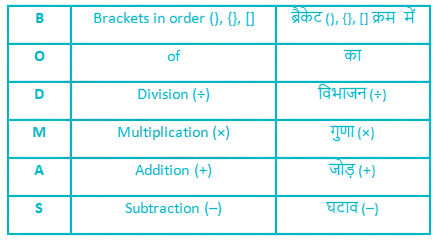
Calculation:
32.01 × 7.12 + 13.98% of 150 + 134.99 ÷ 15.03 = ?
⇒ 32 × 7 + (14/100) × 150 + 135 ÷ 15 = ?
⇒ 224 + 21 + 9 = ?
⇒ ? = 254
∴ 254 should come in place of the question mark (?).
55. What approximate will come in the place of the question mark ‘?’ in the following question?
20.21% of 1249.87 – 19.79 × 5.01 ÷ 9.99 = ? × 79.98
A. 3
B. 6
C. 4
D. 0
E. 30
Solution
Given:
20.21% of 1249.87 – 19.79 × 5.01 ÷ 9.99 = ? × 79.98
Concept:
Follow the BODMAS rule according to the table given below:
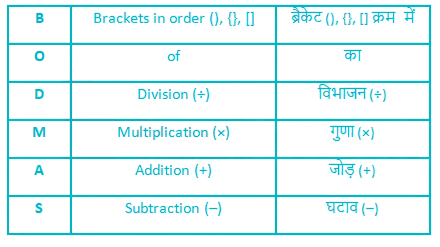
Calculation:
20.21% of 1249.87 – 19.79 × 5.01 ÷ 9.99 = ? × 79.98
⇒ 20% of 1250 – 20 × 5 ÷ 10 = ? × 80
⇒ (1/5) × 1250 – 20 × 5 ÷ 10 = ? × 80
⇒ 250 – 20 × (1/2) = ? × 80
⇒ 250 – 10 = ? × 80
⇒ 240 = ? × 80
⇒ ? = 240/80
⇒ ? = 3
∴ 3 will come in place of the question mark (‘?’).
56. Gulati bhai claims that he sells vegetables at cost price, but he uses false weights. In this manner he gains 25/6%. What is the weight he is using in place of 1 kg weight?
A. 950 g
B. 960 g
C. 930 g
D. 980 g
E. None of the above.
Solution
Given:
(i) Profit = 25/6%
Formula used:
(i) Profit percent = error/true weight – error × 100
Calculations:
⇒ Profit = 25/6%
⇒ Lesser weight = x g
⇒ Price of 1g = 1 Rs.
⇒ CP = x Rs
⇒ SP = 1000 Rs
⇒ Profit = SP – CP
⇒ 1000 – x
⇒ Profit % = [(1000 – x)/x] × 100
⇒ 25/6 = [(1000 – x)/x] × 100
⇒ X = 24000/25
⇒ X = 960
He is using 960 g instead of 1kg.
57. The ratio of the lateral surface area of a cube to a cuboid is 3:2, and the total surface area of the cube is 1944 m². The height of the cuboid is equal to the side of the cube, and the length of the cuboid is 3 meters more than its breadth. If the length of the cuboid is m, then find the value of 12m.
A. 144
B. 162
C. 180
D. 192
E. 214
Solution
Total surface area of cube = 6a² = 1944 m
⇒ a² = 1944 ÷ 6 = 324
⇒ a = √324 = 18 m (side of the cube)
Lateral surface area (LSA) of cube = 4a² = 4 × 324 = 1296 m²
Lateral Surface Area of Cuboid (Given Ratio 3:2):
Let LSA of cuboid = x
Given ratio: 1296 : x = 3 : 2
⇒ x = (1296 × 2) ÷ 3 = 864 m²
Dimensions of Cuboid:
Height (h) = side of cube = 18 m
Let breadth = b
Then, length (m) = b + 3
LSA of cuboid = 2h(l + b) = 864
⇒ 2 × 18 × (b + 3 + b) = 864
⇒ 36 × (2b + 3) = 864
⇒ 2b + 3 = 864 ÷ 36 = 24
⇒ 2b = 21 ⇒ b = 10.5 m
⇒ Length (m) = b + 3 = 13.5 m
m = 13.5
⇒ 12m = 12 × 13.5 = 162
Thus, the correct answer is 162.
58. Directions: The given pie chart shows the degree distribution of the number of stationery items sold in five different shops A, B, C, D and E.
Total items sold in all the shops = 3200
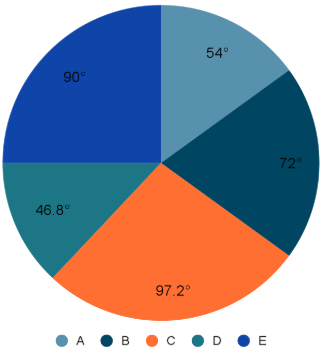
Question:
If the number of pencils, eraser and sharpener sold in shop E respectively are in the ratio 5: 2: 1and the number of pencil, eraser and sharpener sold in shop A respectively are in the ratio 3: 2: 1. Find total sharpener sold in shop E and A.
A. 250
B. 200
C. 180
D. 160
E. 120
Solution
General solution:
Number of stationery items sold in shop A = 54/360 × 3200 = 480
Number of stationery items sold in shop B = 72/260 × 3200 = 640
Number of stationery items sold in shop C = 97.2/360 × 3200 = 864
Number of stationery items sold in shop D = 46.8/360 × 3200 = 416
Number of stationery items sold in shop E = 90/360 × 3200 = 800
Solution:
Number of stationery items sold in shop E = 90/360 × 3200 = 800
Number of sharpener sold in shop E = 800/8 × 1 = 100
Number of stationery items sold in shop A = 54/360 × 3200 = 480
Number of sharpener sold in shop A = 480/6 × 1 =80
Required total = 100 + 80 = 180
59. Directions: The given pie chart shows the degree distribution of the number of stationery items sold in five different shops A, B, C, D and E.
Total items sold in all the shops = 3200
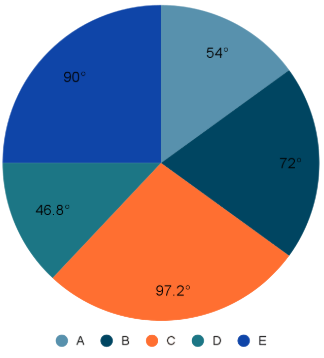
Question:
If 25% of the stationery items sold in shop C is notebooks and from the remaining items 2/3rd are pen and pencils together and further remaining are erasers and sharpeners together. Find the difference between the number of erasers and sharpeners together and notebooks sold in shop C.
A. 9
B. 3
C. 7
D. 0
E. 5
Solution
General solution:
Number of stationery items sold in shop A = 54/360 × 3200 = 480
Number of stationery items sold in shop B = 72/260 × 3200 = 640
Number of stationery items sold in shop C = 97.2/360 × 3200 = 864
Number of stationery items sold in shop D = 46.8/360 × 3200 = 416
Number of stationery items sold in shop E = 90/360 × 3200 = 800
Solution:
Number of stationery items sold in shop C = 97.2/360 × 3200 = 864
Number of notebooks sold = 864 × 25/100 = 216
Number of pen and pencils sold = 864 – 216 = 648 × 2/3 = 432
Number of erasers and sharpeners sold = 648 – 432 = 216
Required difference = 216 – 216 = 0
60. Directions: The given pie chart shows the degree distribution of the number of stationery items sold in five different shops A, B, C, D and E.
Total items sold in all the shops = 3200
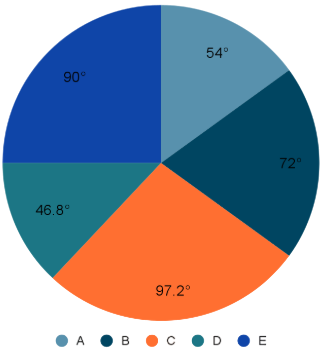
Question:
Find the ratio between the difference of number of stationery items sold in shop A and B to the number of stationery items sold in shop E.
A. 2: 1
B. 1: 5
C. 2: 3
D. 3: 5
E. 1: 3
Solution
General solution:
Number of stationery items sold in shop A = 54/360 × 3200 = 480
Number of stationery items sold in shop B = 72/260 × 3200 = 640
Number of stationery items sold in shop C = 97.2/360 × 3200 = 864
Number of stationery items sold in shop D = 46.8/360 × 3200 = 416
Number of stationery items sold in shop E = 90/360 × 3200 = 800
Solution:
Number of stationery item sold in shop A = 480
Number of stationery item sold in shop B = 640
Number of stationery item sold in shop E = 800
Required ratio = (640 – 480): 800 = 160: 800 = 1: 5
61. Directions: The given pie chart shows the degree distribution of the number of stationery items sold in five different shops A, B, C, D and E.
Total items sold in all the shops = 3200
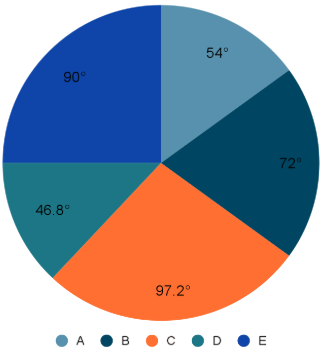
Question:
If the number of stationery items sold in shop E is increased by 30% and the number of stationery items sold in shop B is increased by 25%. Find the difference between the number of stationery items sold in shop E and the number of stationery items sold in shop B.
A. 320
B. 280
C. 240
D. 210
E. 200
Solution
General solution:
Number of stationery items sold in shop A = 54/360 × 3200 = 480
Number of stationery items sold in shop B = 72/260 × 3200 = 640
Number of stationery items sold in shop C = 97.2/360 × 3200 = 864
Number of stationery items sold in shop D = 46.8/360 × 3200 = 416
Number of stationery items sold in shop E = 90/360 × 3200 = 800
Solution:
Number of stationery items sold in shop E = 90/360 × 3200 = 800
Number of stationery item sold in shop E is increased by 30% = 800 × 130/100 = 1040
Number of stationery item sold in shop B = 640
Number of stationery item sold in shop E is increased by 25% = 640 × 125/100 = 800
Required difference = 1040 – 800 = 240
62. Directions: The given pie chart shows the degree distribution of the number of stationery items sold in five different shops A, B, C, D and E.
Total items sold in all the shops = 3200

Question:
Number of stationery items sold in shop F is 100 more than the number of stationery items sold in shop B. Find 50% of the stationery items sold in the shop F
A. 240
B. 280
C. 320
D. 370
E. 210
Solution
General solution:
Number of stationery items sold in shop A = 54/360 × 3200 = 480
Number of stationery items sold in shop B = 72/260 × 3200 = 640
Number of stationery items sold in shop C = 97.2/360 × 3200 = 864
Number of stationery items sold in shop D = 46.8/360 × 3200 = 416
Number of stationery items sold in shop E = 90/360 × 3200 = 800
Solution:
Number of stationery item sold in the shop B = 640
Number of stationery item sold in the shop F = 640 + 100 = 740
50% of the number of stationery item sold = 740 × 50/100 = 370
63. A is even prime number. B is highest single digit perfect square number. C is perfect square number. Sum of C and cube of A is not more than 35 but more than 26. D is square of B.
Quantity I Find the value A ×D ?
Quantity II Find the value of B ×C?
A. Quantity II > Quantity I
B. Quantity II ≥ Quantity I
C. Quantity I > Quantity II
D. Quantity I ≥ Quantity II
E. Quantity I = Quantity II or Relation cannot be established
Solution
Calculation
A is even prime number. so A is 2.
B is highest single digit perfect square number.
So, B is 9.
C is perfect square number.
According the condition C must be 25.
25 + 8 = 33
And 25 – 8 = 17
And D is 9×9 = 81
So,
Quantity I Find the value A ×D
A ×D = 2 × 81 = 162
Quantity II Find the value of B ×C?
B×C = 25 × 9 = 225
So, Quantity II > Quantity I
64. Quantity I: The bus was covering a distance of 480 km, if the speed of the bus is increased by 2 km/hr then it takes 1 hour less to cover the same distance then find the new speed of bus?
Quantity II: If the speed of A is 50% of speed of B and takes 4 hours more than B to cover the distance of 120 km then find the average speed of A and B?
A. Quantity I > Quantity II
B. Quantity I < Quantity II
C. Quantity I ≥ Quantity II
D. Quantity I ≤ Quantity II
E. Quantity I = Quantity II or relationship cannot be determined
Solution
Solution:
Quantity I:
Let assume the initial speed of bus as ‘S’ km/hr and time taken to cover the given distance as ‘T’ km.
Case 1
S = 480/T 🡪(1)
Case 2
S + 2 = 480/(T – 1) 🡪(2)
Equation (1) sub in (2)
(480/T) + 2 = 480/ (T – 1)
[480/ (T – 1)] – [480/T] = 2
480 = 2 (T2 – T)
T2 – T – 240 = 0
To solve the equation to get the value
T = 16 (or) -15
We consider only positive integer so, T = 16
Then
New speed = 480/ (16 – 1)
= 32 km/hr
Quantity II:
Speed of A = (50/100) × speed of B
Speed of A: speed of B = 1: 2 = x: 2x
Then
[120/x] – [120/2x] = 4
(240 – 120)/2x = 4
x = 15 km/hr
Let
Speed of A = 15 km/hr
Speed of B = 30 km/hr
Time taken by A = 120/15 = 8 hours
Time taken by B = 120/30 = 4 hours
Then
When the distance travelled is same, then
Average speed = 2UV/(U + V)
Average speed
= 900/45
= 20 km/hr
Quantity I > Quantity II
65. Directions: Two quantities A and B are given in the following questions. You have to find the value to both A and B by using your knowledge of mathematics and choose the most suitable relation between the magnitude of A and B from the given options.
Quantity A – Salary of X. Ratio of salaries of X and Y is 4 : 5 while ratio of expenditure of X and Y is 7 : 9. X saves 1100 and Y saves 1300.
Quantity B – Cost price of cycle. The cost of cycle depreciates by 20% in first year and 10% in second year. After 2 years, it is sold for Rs. 2880 at profit percent of 25.
A. Quantity A ≥ Quantity B
B. Quantity A ≤ Quantity B
C. Quantity A = Quantity B or no relationship can be established
D. Quantity A > Quantity B
E. Quantity A < Quantity B
Solution
Quantity A –
Let salaries be 4x and 5x and expenditures be 7y and 9y.
According to condition,
4x – 7y = 1100
5x – 9y = 1300
Solving both we get, x = 800 and y = 300
Salary of X = 4x = Rs. 3200
Quantity B –
Let CP of cycle be 100x
Cost after 2 years = (100 – 10) % of (100 – 20)% of 100x = 72x
Selling price at 25% profit = (5 / 4) of 72x = 90x
90x = 2880
⇒ x = 32
⇒ 100x = 3200Hence, Quantity A = Quantity B or no relationship can be established
66. Direction: Read the following information carefully and answer the questions based on given information.
A person downloads eight different gaming apps one after another which are Brain Out, Chess, Candy Crush, Free Fire, Ludo King, PubG, Temple run and UNO but not necessarily in same order. Only three games are downloaded between the Ludo King and the UNO. As many games downloaded before Temple Run as many after the Brain Out. Only one game is downloaded between Free Fire and Candy Crush which is downloaded either just before Ludo King or just after Ludo King. The Temple Run downloaded before the game of Free Fire. The Chess was downloaded after the PubG but before the Brain Out. Ludo King was downloaded before the game of UNO. Not more than one game is downloaded between Free Fire and PubG. The game of Chess was not downloaded just before the game of Brain Out.
Question:
Which of the following pair represent the game downloaded immediately before and after the game of UNO?
A. Candy Crush, Chess
B. PubG, Brain Out
C. Brain Out, Free Fire
D. Chess, Brain Out
E. Free Fire, Chess
Solution
Here, the games are Brain Out, Chess, Candy Crush, Free Fire, Ludo King, PubG, Temple run and UNO.
1) Ludo King was downloaded before the game of UNO.
2) Only three games are downloaded between the Ludo King and the UNO.
3) Only one game is downloaded between Free Fire and Candy Crush which is downloaded either just before Ludo King or just after Ludo King.
| Case – 1 | Case – 2 | Case – 3 | Case – 4 | Case – 5 | Case – 6 | Case – 7 |
| Games | Games | Games | Games | Games | Games | Persons |
| Ludo King | Candy Crush | |||||
| Candy Crush | Ludo King | Ludo King | Candy Crush | |||
| Free Fire | Candy Crush | Ludo King | Ludo King | Candy Crush | ||
| Free Fire | Candy Crush | Ludo King | Ludo King | |||
| UNO | Candy Crush | |||||
| UNO | UNO | |||||
| UNO | UNO | |||||
| UNO | UNO |
4) The Temple Run downloaded before the game of Free Fire. So, case 2 is eliminated.
5) As many games downloaded before Temple Run as many after the Brain Out.
6) The Chess was downloaded after the PubG but before the Brain Out. By combining condition 5 and 6, case 1 is eliminated.
| Case – 3 | Case – 4 | Case – 5(a) | Case – 5(b) | Case – 6 | Case – 7 |
| Games | Games | Games | Games | Games | Persons |
| Temple Run | Temple Run | Temple Run | Temple Run | ||
| Ludo King | Candy Crush | Free Fire | Temple Run | Temple Run | |
| Candy Crush | Ludo King | Ludo King | Ludo King | Candy Crush | Free Fire |
| Free Fire | Candy Crush | Candy Crush | Ludo King | Ludo King | |
| Free Fire | Free Fire | Candy Crush | |||
| UNO | Free Fire | ||||
| UNO | UNO | UNO | Brain Out | Brain Out | |
| Brain Out | Brain Out | Brain Out | Brain Out | UNO | UNO |
7) Not more than one game is downloaded between Free Fire and PubG. Therefore, case 5(a), 5(b), 6 are eliminated.
8) The game of Chess was not downloaded just before the game of Brain Out. Therefore, case 3 and case 7 are eliminated. Hence, the final arrangement is as follows
| Games |
| Temple Run |
| Candy Crush |
| Ludo King |
| Free Fire |
| PubG |
| Chess |
| UNO |
| Brain Out |
Hence, Chess is downloaded immediately before and Brain Out is downloaded immediately after the game of UNO.
67. Direction: Read the following information carefully and answer the questions based on given information.
A person downloads eight different gaming apps one after another which are Brain Out, Chess, Candy Crush, Free Fire, Ludo King, PubG, Temple run and UNO but not necessarily in same order. Only three games are downloaded between the Ludo King and the UNO. As many games downloaded before Temple Run as many after the Brain Out. Only one game is downloaded between Free Fire and Candy Crush which is downloaded either just before Ludo King or just after Ludo King. The Temple Run downloaded before the game of Free Fire. The Chess was downloaded after the PubG but before the Brain Out. Ludo King was downloaded before the game of UNO. Not more than one game is downloaded between Free Fire and PubG. The game of Chess was not downloaded just before the game of Brain Out.
Question:
How many games are downloaded before the game of Candy Crush?
A. Three
B. One
C. None
D. Two
E. More than three
Solution
Here, the games are Brain Out, Chess, Candy Crush, Free Fire, Ludo King, PubG, Temple run and UNO.
1) Ludo King was downloaded before the game of UNO.
2) Only three games are downloaded between the Ludo King and the UNO.
3) Only one game is downloaded between Free Fire and Candy Crush which is downloaded either just before Ludo King or just after Ludo King.
| Case – 1 | Case – 2 | Case – 3 | Case – 4 | Case – 5 | Case – 6 | Case – 7 |
| Games | Games | Games | Games | Games | Games | Persons |
| Ludo King | Candy Crush | |||||
| Candy Crush | Ludo King | Ludo King | Candy Crush | |||
| Free Fire | Candy Crush | Ludo King | Ludo King | Candy Crush | ||
| Free Fire | Candy Crush | Ludo King | Ludo King | |||
| UNO | Candy Crush | |||||
| UNO | UNO | |||||
| UNO | UNO | |||||
| UNO | UNO |
4) The Temple Run downloaded before the game of Free Fire. So, case 2 is eliminated.
5) As many games downloaded before Temple Run as many after the Brain Out.
6) The Chess was downloaded after the PubG but before the Brain Out. By combining condition 5 and 6, case 1 is eliminated.
| Case – 3 | Case – 4 | Case – 5(a) | Case – 5(b) | Case – 6 | Case – 7 |
| Games | Games | Games | Games | Games | Persons |
| Temple Run | Temple Run | Temple Run | Temple Run | ||
| Ludo King | Candy Crush | Free Fire | Temple Run | Temple Run | |
| Candy Crush | Ludo King | Ludo King | Ludo King | Candy Crush | Free Fire |
| Free Fire | Candy Crush | Candy Crush | Ludo King | Ludo King | |
| Free Fire | Free Fire | Candy Crush | |||
| UNO | Free Fire | ||||
| UNO | UNO | UNO | Brain Out | Brain Out | |
| Brain Out | Brain Out | Brain Out | Brain Out | UNO | UNO |
7) Not more than one game is downloaded between Free Fire and PubG. Therefore, case 5(a), 5(b), 6 are eliminated.
8) The game of Chess was not downloaded just before the game of Brain Out. Therefore, case 3 and case 7 are eliminated. Hence, the final arrangement is as follows
| Games |
| Temple Run |
| Candy Crush |
| Ludo King |
| Free Fire |
| PubG |
| Chess |
| UNO |
| Brain Out |
Hence, only one game is downloaded before the game of Candy Crush.
68. Direction: Read the following information carefully and answer the questions based on given information.
A person downloads eight different gaming apps one after another which are Brain Out, Chess, Candy Crush, Free Fire, Ludo King, PubG, Temple run and UNO but not necessarily in same order. Only three games are downloaded between the Ludo King and the UNO. As many games downloaded before Temple Run as many after the Brain Out. Only one game is downloaded between Free Fire and Candy Crush which is downloaded either just before Ludo King or just after Ludo King. The Temple Run downloaded before the game of Free Fire. The Chess was downloaded after the PubG but before the Brain Out. Ludo King was downloaded before the game of UNO. Not more than one game is downloaded between Free Fire and PubG. The game of Chess was not downloaded just before the game of Brain Out.
Question:
Which of the following statement(s) is/ are incorrect?
A. Brain Out is the last game to be downloaded.
B. Only two games are downloaded before Ludo King.
C. The UNO game is downloaded just before the Brain Out.
D. Free Fire is downloaded just before Ludo King
E. All are correct
Solution
Here, the games are Brain Out, Chess, Candy Crush, Free Fire, Ludo King, PubG, Temple run and UNO.
1) Ludo King was downloaded before the game of UNO.
2) Only three games are downloaded between the Ludo King and the UNO.
3) Only one game is downloaded between Free Fire and Candy Crush which is downloaded either just before Ludo King or just after Ludo King.
| Case – 1 | Case – 2 | Case – 3 | Case – 4 | Case – 5 | Case – 6 | Case – 7 |
| Games | Games | Games | Games | Games | Games | Persons |
| Ludo King | Candy Crush | |||||
| Candy Crush | Ludo King | Ludo King | Candy Crush | |||
| Free Fire | Candy Crush | Ludo King | Ludo King | Candy Crush | ||
| Free Fire | Candy Crush | Ludo King | Ludo King | |||
| UNO | Candy Crush | |||||
| UNO | UNO | |||||
| UNO | UNO | |||||
| UNO | UNO |
4) The Temple Run downloaded before the game of Free Fire. So, case 2 is eliminated.
5) As many games downloaded before Temple Run as many after the Brain Out.
6) The Chess was downloaded after the PubG but before the Brain Out. By combining condition 5 and 6, case 1 is eliminated.
| Case – 3 | Case – 4 | Case – 5(a) | Case – 5(b) | Case – 6 | Case – 7 |
| Games | Games | Games | Games | Games | Persons |
| Temple Run | Temple Run | Temple Run | Temple Run | ||
| Ludo King | Candy Crush | Free Fire | Temple Run | Temple Run | |
| Candy Crush | Ludo King | Ludo King | Ludo King | Candy Crush | Free Fire |
| Free Fire | Candy Crush | Candy Crush | Ludo King | Ludo King | |
| Free Fire | Free Fire | Candy Crush | |||
| UNO | Free Fire | ||||
| UNO | UNO | UNO | Brain Out | Brain Out | |
| Brain Out | Brain Out | Brain Out | Brain Out | UNO | UNO |
7) Not more than one game is downloaded between Free Fire and PubG. Therefore, case 5(a), 5(b), 6 are eliminated.
8) The game of Chess was not downloaded just before the game of Brain Out. Therefore, case 3 and case 7 are eliminated. Hence, the final arrangement is as follows
| Games |
| Temple Run |
| Candy Crush |
| Ludo King |
| Free Fire |
| PubG |
| Chess |
| UNO |
| Brain Out |
Since, Free Fire is downloaded just after Ludo King.
Hence, the incorrect statement is Free Fire is downloaded just before Ludo King.
69. Direction: Read the following information carefully and answer the questions based on given information.
A person downloads eight different gaming apps one after another which are Brain Out, Chess, Candy Crush, Free Fire, Ludo King, PubG, Temple run and UNO but not necessarily in same order. Only three games are downloaded between the Ludo King and the UNO. As many games downloaded before Temple Run as many after the Brain Out. Only one game is downloaded between Free Fire and Candy Crush which is downloaded either just before Ludo King or just after Ludo King. The Temple Run downloaded before the game of Free Fire. The Chess was downloaded after the PubG but before the Brain Out. Ludo King was downloaded before the game of UNO. Not more than one game is downloaded between Free Fire and PubG. The game of Chess was not downloaded just before the game of Brain Out.
Question:
Which game is downloaded exactly between Free Fire and Chess?
A. Ludo King
B. UNO
C. PubG
D. Brain Out
E. Temple Run
Solution
Here, the games are Brain Out, Chess, Candy Crush, Free Fire, Ludo King, PubG, Temple run and UNO.
1) Ludo King was downloaded before the game of UNO.
2) Only three games are downloaded between the Ludo King and the UNO.
3) Only one game is downloaded between Free Fire and Candy Crush which is downloaded either just before Ludo King or just after Ludo King.
| Case – 1 | Case – 2 | Case – 3 | Case – 4 | Case – 5 | Case – 6 | Case – 7 |
| Games | Games | Games | Games | Games | Games | Persons |
| Ludo King | Candy Crush | |||||
| Candy Crush | Ludo King | Ludo King | Candy Crush | |||
| Free Fire | Candy Crush | Ludo King | Ludo King | Candy Crush | ||
| Free Fire | Candy Crush | Ludo King | Ludo King | |||
| UNO | Candy Crush | |||||
| UNO | UNO | |||||
| UNO | UNO | |||||
| UNO | UNO |
4) The Temple Run downloaded before the game of Free Fire. So, case 2 is eliminated.
5) As many games downloaded before Temple Run as many after the Brain Out.
6) The Chess was downloaded after the PubG but before the Brain Out. By combining condition 5 and 6, case 1 is eliminated.
| Case – 3 | Case – 4 | Case – 5(a) | Case – 5(b) | Case – 6 | Case – 7 |
| Games | Games | Games | Games | Games | Persons |
| Temple Run | Temple Run | Temple Run | Temple Run | ||
| Ludo King | Candy Crush | Free Fire | Temple Run | Temple Run | |
| Candy Crush | Ludo King | Ludo King | Ludo King | Candy Crush | Free Fire |
| Free Fire | Candy Crush | Candy Crush | Ludo King | Ludo King | |
| Free Fire | Free Fire | Candy Crush | |||
| UNO | Free Fire | ||||
| UNO | UNO | UNO | Brain Out | Brain Out | |
| Brain Out | Brain Out | Brain Out | Brain Out | UNO | UNO |
7) Not more than one game is downloaded between Free Fire and PubG. Therefore, case 5(a), 5(b), 6 are eliminated.
8) The game of Chess was not downloaded just before the game of Brain Out. Therefore, case 3 and case 7 are eliminated. Hence, the final arrangement is as follows
| Games |
| Temple Run |
| Candy Crush |
| Ludo King |
| Free Fire |
| PubG |
| Chess |
| UNO |
| Brain Out |
Hence, PubG was downloaded exactly between Free Fire and Chess.
70. Direction: Read the following information carefully and answer the questions based on given information.
A person downloads eight different gaming apps one after another which are Brain Out, Chess, Candy Crush, Free Fire, Ludo King, PubG, Temple run and UNO but not necessarily in same order. Only three games are downloaded between the Ludo King and the UNO. As many games downloaded before Temple Run as many after the Brain Out. Only one game is downloaded between Free Fire and Candy Crush which is downloaded either just before Ludo King or just after Ludo King. The Temple Run downloaded before the game of Free Fire. The Chess was downloaded after the PubG but before the Brain Out. Ludo King was downloaded before the game of UNO. Not more than one game is downloaded between Free Fire and PubG. The game of Chess was not downloaded just before the game of Brain Out.
Question:
Which game was the first one to be downloaded?
A. Candy Crush
B. Temple Run
C. Ludo King
D. PubG
E. None of these
Solution
Here, the games are Brain Out, Chess, Candy Crush, Free Fire, Ludo King, PubG, Temple run and UNO.
1) Ludo King was downloaded before the game of UNO.
2) Only three games are downloaded between the Ludo King and the UNO.
3) Only one game is downloaded between Free Fire and Candy Crush which is downloaded either just before Ludo King or just after Ludo King.
| Case – 1 | Case – 2 | Case – 3 | Case – 4 | Case – 5 | Case – 6 | Case – 7 |
| Games | Games | Games | Games | Games | Games | Persons |
| Ludo King | Candy Crush | |||||
| Candy Crush | Ludo King | Ludo King | Candy Crush | |||
| Free Fire | Candy Crush | Ludo King | Ludo King | Candy Crush | ||
| Free Fire | Candy Crush | Ludo King | Ludo King | |||
| UNO | Candy Crush | |||||
| UNO | UNO | |||||
| UNO | UNO | |||||
| UNO | UNO |
4) The Temple Run downloaded before the game of Free Fire. So, case 2 is eliminated.
5) As many games downloaded before Temple Run as many after the Brain Out.
6) The Chess was downloaded after the PubG but before the Brain Out. By combining condition 5 and 6, case 1 is eliminated.
| Case – 3 | Case – 4 | Case – 5(a) | Case – 5(b) | Case – 6 | Case – 7 |
| Games | Games | Games | Games | Games | Persons |
| Temple Run | Temple Run | Temple Run | Temple Run | ||
| Ludo King | Candy Crush | Free Fire | Temple Run | Temple Run | |
| Candy Crush | Ludo King | Ludo King | Ludo King | Candy Crush | Free Fire |
| Free Fire | Candy Crush | Candy Crush | Ludo King | Ludo King | |
| Free Fire | Free Fire | Candy Crush | |||
| UNO | Free Fire | ||||
| UNO | UNO | UNO | Brain Out | Brain Out | |
| Brain Out | Brain Out | Brain Out | Brain Out | UNO | UNO |
7) Not more than one game is downloaded between Free Fire and PubG. Therefore, case 5(a), 5(b), 6 are eliminated.
8) The game of Chess was not downloaded just before the game of Brain Out. Therefore, case 3 and case 7 are eliminated. Hence, the final arrangement is as follows
| Games |
| Temple Run |
| Candy Crush |
| Ludo King |
| Free Fire |
| PubG |
| Chess |
| UNO |
| Brain Out |
Hence, Temple Run is the first game to be downloaded.
71. Directions: In the following question assuming the given statements to be true, find which of the conclusion among the given conclusions is/are definitely true and then give your answers accordingly.
Statements:
A = N ≥ L > O < G ≤ Y; O < L ≤ S < N
Conclusions:
I. S > O
II. G < S
A. Only I follow
B. Only II follow
C. Both I and II follow
D. Neither I nor II follow
E. Either I or II follow
Solution
Given statements:
A = N ≥ L > O < G ≤ Y; O < L ≤ S < N
On combining:
N > S ≥ L > O < G ≤ Y
Conclusions:
1. S > O → True (As N > S ≥ L > O < G ≤ Y à S > O. So, it is true)
2. G < S → False (There is no relation between G and S because of the opposite sign between G and S)Hence, only I follow.
72. Directions: In the following question assuming the given statements to be true, find which of the conclusion among the given conclusions is/are definitely true and then give your answers accordingly.
Statements:
X = Y < Z ≤ A; B < A ≤ C; D ≤ X < E
Conclusions:
I. D < C
II. B > E
A. Only I follow
B. Only II follow
C. Both I and II follow
D. Neither I nor II follow
E. Either I or II follow
Solution
Given statements:
X = Y < Z ≤ A; B < A ≤ C; D ≤ X < E
On Combining:
X = Y < Z ≤ A ≤ C
E > X = Y < Z ≤ A > B , D ≤ X = Y < Z ≤ A ≤ C
Conclusions:
1. D < C → True (D ≤ X = Y < Z ≤ A ≤ C, thus the conclusion follow)
2. B > E → False (As E > X = Y < Z ≤ A > B, there is no relation between E and B because of the opposite sign between E and B)Hence, only I follow.
73. Direction: Read the following information carefully and answer the questions based on given information.
Six friends Aarav, Kartik, Ram, Rahul, Sam and Yuvraj going to give a banking examination on three different months March, May and July on two different dates i.e. 5 and 17, on the same year, not necessary in the same order. Each of the person got different marks which are 25, 29, 60, 75, 81 and 92 but not in same order. The person who got perfect square number of marks gave the exam on same date but on different months. Ram and Sam gave their exam on same date but not in May. Kartik got three times marks as of marks secured by Yuvraj. The number of person gave their exam between Aarav and Sam is a least natural number. The difference between marks secured by Rahul and Kartik is a multiple of 3. Aarav gave his exam one of the days before Kartik but not immediately before. Rahul gave his exam immediately after Ram. Ram got two more marks than twice the marks of the person who gave his exam on 5th July.
Question:
Which of the following pair is correctly matched?
A. Ram – 5th July
B. Rahul – 17th July
C. Aarav – 17th May
D. Sam – 5th July
E. Kartik – 17th May
Solution
Here, friends are Aarav, Kartik, Ram, Rahul, Sam and Yuvraj and the marks are 25, 29, 60, 75, 81 and 92.
1) Ram and Sam gave their exam on same date but not in May.
2) The number of person gave their exam between Aarav and Sam is a least natural number i.e. 1.
3) Rahul gave his exam immediately after Ram.
| Months | Dates | Case – 1 | Case – 2 | Case – 3 | |||
| Persons | Marks | Persons | Marks | Persons | Marks | ||
| March | 5 | Ram | Sam | ||||
| 17 | Rahul | Ram | |||||
| May | 5 | Aarav | Rahul | Aarav | |||
| 17 | Aarav | ||||||
| July | 5 | Sam | Ram | ||||
| 17 | Sam | Rahul | |||||
4) Aarav gave his exam one of the days before Kartik but not immediately before.
5) Ram got two more marks than twice the marks of the person who gave his exam on 5th July. The only possibility is person gave exam on 5th July got marks 29 so Ram got 60 marks. So, case 3 is eliminated since Ram could not give exam on 5th July.
| Months | Dates | Case – 1 | Case – 2 | ||
| Persons | Marks | Persons | Marks | ||
| March | 5 | Ram | 60 | ||
| 17 | Rahul | Ram | 60 | ||
| May | 5 | Aarav | Rahul | ||
| 17 | Aarav | ||||
| July | 5 | Sam | 29 | ||
| 17 | Sam | 29 | |||
6) Kartik got three times marks as of marks secured by Yuvraj. Therefore, Yuvraj got 25 marks and Kartik got 75 marks.
7) The difference between marks secured by Rahul and Kartik is a multiple of 3. The only possibility is Rahul got 81 marks.
Therefore, Aarav got 92 marks.
8) The person who got perfect square number of marks gave the exam on same date but on different months.
| Months | Dates | Case – 1 | Case – 2 | ||
| Persons | Marks | Persons | Marks | ||
| March | 5 | Ram | 60 | ||
| 17 | Rahul | 81 | Ram | 60 | |
| May | 5 | Aarav | 92 | Rahul | 81 |
| 17 | Aarav | 92 | |||
| July | 5 | Sam | 29 | ||
| 17 | Sam | 29 | |||
Since, Aarav gave his exam one of the days before Kartik but not immediately before. Therefore, case 2 is eliminated. Hence, the final arrangement is as follows
| Months | Date | Persons | Marks |
| March | 5 | Ram | 60 |
| 17 | Rahul | 81 | |
| May | 5 | Aarav | 92 |
| 17 | Yuvraj | 25 | |
| July | 5 | Sam | 29 |
| 17 | Kartik | 75 |
Hence, the correct pair is Sam – 5th July.
74. Comprehension:(Que No. 8 – 12)
Direction: Read the following information carefully and answer the questions based on given information.
Six friends Aarav, Kartik, Ram, Rahul, Sam and Yuvraj going to give a banking examination on three different months March, May and July on two different dates i.e. 5 and 17, on the same year, not necessary in the same order. Each of the person got different marks which are 25, 29, 60, 75, 81 and 92 but not in same order. The person who got perfect square number of marks gave the exam on same date but on different months. Ram and Sam gave their exam on same date but not in May. Kartik got three times marks as of marks secured by Yuvraj. The number of person gave their exam between Aarav and Sam is a least natural number. The difference between marks secured by Rahul and Kartik is a multiple of 3. Aarav gave his exam one of the days before Kartik but not immediately before. Rahul gave his exam immediately after Ram. Ram got two more marks than twice the marks of the person who gave his exam on 5th July.
Question:
Which of the following statement is incorrect regarding Kartik?
A. Kartik gave his exam on 5th July.
B. Yuvraj gave his exam one of the days before Kartik.
C. More than two person gave exam between Ram and Kartik.
D. Aarav and Kartik gave exam on different dates of same month.
E. More than one option.
Solution
Here, friends are Aarav, Kartik, Ram, Rahul, Sam and Yuvraj and the marks are 25, 29, 60, 75, 81 and 92.
1) Ram and Sam gave their exam on same date but not in May.
2) The number of person gave their exam between Aarav and Sam is a least natural number i.e. 1.
3) Rahul gave his exam immediately after Ram.
| Months | Dates | Case – 1 | Case – 2 | Case – 3 | |||
| Persons | Marks | Persons | Marks | Persons | Marks | ||
| March | 5 | Ram | Sam | ||||
| 17 | Rahul | Ram | |||||
| May | 5 | Aarav | Rahul | Aarav | |||
| 17 | Aarav | ||||||
| July | 5 | Sam | Ram | ||||
| 17 | Sam | Rahul | |||||
4) Aarav gave his exam one of the days before Kartik but not immediately before.
5) Ram got two more marks than twice the marks of the person who gave his exam on 5th July. The only possibility is person gave exam on 5th July got marks 29 so Ram got 60 marks. So, case 3 is eliminated since Ram could not give exam on 5th July.
| Months | Dates | Case – 1 | Case – 2 | ||
| Persons | Marks | Persons | Marks | ||
| March | 5 | Ram | 60 | ||
| 17 | Rahul | Ram | 60 | ||
| May | 5 | Aarav | Rahul | ||
| 17 | Aarav | ||||
| July | 5 | Sam | 29 | ||
| 17 | Sam | 29 | |||
6) Kartik got three times marks as of marks secured by Yuvraj. Therefore, Yuvraj got 25 marks and Kartik got 75 marks.
7) The difference between marks secured by Rahul and Kartik is a multiple of 3. The only possibility is Rahul got 81 marks.
Therefore, Aarav got 92 marks.
8) The person who got perfect square number of marks gave the exam on same date but on different months.
| Months | Dates | Case – 1 | Case – 2 | ||
| Persons | Marks | Persons | Marks | ||
| March | 5 | Ram | 60 | ||
| 17 | Rahul | 81 | Ram | 60 | |
| May | 5 | Aarav | 92 | Rahul | 81 |
| 17 | Aarav | 92 | |||
| July | 5 | Sam | 29 | ||
| 17 | Sam | 29 | |||
Since, Aarav gave his exam one of the days before Kartik but not immediately before. Therefore, case 2 is eliminated. Hence, the final arrangement is as follows
| Months | Date | Persons | Marks |
| March | 5 | Ram | 60 |
| 17 | Rahul | 81 | |
| May | 5 | Aarav | 92 |
| 17 | Yuvraj | 25 | |
| July | 5 | Sam | 29 |
| 17 | Kartik | 75 |
Since, Kartik gave his exam on 17th July so statement first is incorrect.
Yuvraj gave his exam one of the days before Kartik. So, statement second is correct.
Four persons gave exam between Ram and Kartik. So, statement third is also correct.
Aarav and Kartik gave exam on different dates of different months. So, statement fourth is incorrect.
Hence, the correct answer is more than one option.
75. Direction: Read the following information carefully and answer the questions based on given information.
Six friends Aarav, Kartik, Ram, Rahul, Sam and Yuvraj going to give a banking examination on three different months March, May and July on two different dates i.e. 5 and 17, on the same year, not necessary in the same order. Each of the person got different marks which are 25, 29, 60, 75, 81 and 92 but not in same order. The person who got perfect square number of marks gave the exam on same date but on different months. Ram and Sam gave their exam on same date but not in May. Kartik got three times marks as of marks secured by Yuvraj. The number of person gave their exam between Aarav and Sam is a least natural number. The difference between marks secured by Rahul and Kartik is a multiple of 3. Aarav gave his exam one of the days before Kartik but not immediately before. Rahul gave his exam immediately after Ram. Ram got two more marks than twice the marks of the person who gave his exam on 5th July.
Question:
Which of the following statement(s) is/ are correct?
A. Ram gave his exam on 17th March.
B. Sam gave his marks on 5th March.
C. Rahul got the highest marks.
D. Yuvraj got the marks which is a perfect square.
E. All are correct.
Solution
Here, friends are Aarav, Kartik, Ram, Rahul, Sam and Yuvraj and the marks are 25, 29, 60, 75, 81 and 92.
1) Ram and Sam gave their exam on same date but not in May.
2) The number of person gave their exam between Aarav and Sam is a least natural number i.e. 1.
3) Rahul gave his exam immediately after Ram.
| Months | Dates | Case – 1 | Case – 2 | Case – 3 | |||
| Persons | Marks | Persons | Marks | Persons | Marks | ||
| March | 5 | Ram | Sam | ||||
| 17 | Rahul | Ram | |||||
| May | 5 | Aarav | Rahul | Aarav | |||
| 17 | Aarav | ||||||
| July | 5 | Sam | Ram | ||||
| 17 | Sam | Rahul | |||||
4) Aarav gave his exam one of the days before Kartik but not immediately before.
5) Ram got two more marks than twice the marks of the person who gave his exam on 5th July. The only possibility is person gave exam on 5th July got marks 29 so Ram got 60 marks. So, case 3 is eliminated since Ram could not give exam on 5th July.
| Months | Dates | Case – 1 | Case – 2 | ||
| Persons | Marks | Persons | Marks | ||
| March | 5 | Ram | 60 | ||
| 17 | Rahul | Ram | 60 | ||
| May | 5 | Aarav | Rahul | ||
| 17 | Aarav | ||||
| July | 5 | Sam | 29 | ||
| 17 | Sam | 29 | |||
6) Kartik got three times marks as of marks secured by Yuvraj. Therefore, Yuvraj got 25 marks and Kartik got 75 marks.
7) The difference between marks secured by Rahul and Kartik is a multiple of 3. The only possibility is Rahul got 81 marks.
Therefore, Aarav got 92 marks.
8) The person who got perfect square number of marks gave the exam on same date but on different months.
| Months | Dates | Case – 1 | Case – 2 | ||
| Persons | Marks | Persons | Marks | ||
| March | 5 | Ram | 60 | ||
| 17 | Rahul | 81 | Ram | 60 | |
| May | 5 | Aarav | 92 | Rahul | 81 |
| 17 | Aarav | 92 | |||
| July | 5 | Sam | 29 | ||
| 17 | Sam | 29 | |||
Since, Aarav gave his exam one of the days before Kartik but not immediately before. Therefore, case 2 is eliminated. Hence, the final arrangement is as follows
| Months | Date | Persons | Marks |
| March | 5 | Ram | 60 |
| 17 | Rahul | 81 | |
| May | 5 | Aarav | 92 |
| 17 | Yuvraj | 25 | |
| July | 5 | Sam | 29 |
| 17 | Kartik | 75 |
Hence, the correct statement is Yuvraj got the perfect square marks.
76. Direction: Read the following information carefully and answer the questions based on given information.
Six friends Aarav, Kartik, Ram, Rahul, Sam and Yuvraj going to give a banking examination on three different months March, May and July on two different dates i.e. 5 and 17, on the same year, not necessary in the same order. Each of the person got different marks which are 25, 29, 60, 75, 81 and 92 but not in same order. The person who got perfect square number of marks gave the exam on same date but on different months. Ram and Sam gave their exam on same date but not in May. Kartik got three times marks as of marks secured by Yuvraj. The number of person gave their exam between Aarav and Sam is a least natural number. The difference between marks secured by Rahul and Kartik is a multiple of 3. Aarav gave his exam one of the days before Kartik but not immediately before. Rahul gave his exam immediately after Ram. Ram got two more marks than twice the marks of the person who gave his exam on 5th July.
Question:
Who among them got the highest marks?
A. Ram
B. Sam
C. Yuvraj
D. Aarav
E. Kartik
Solution
Here, friends are Aarav, Kartik, Ram, Rahul, Sam and Yuvraj and the marks are 25, 29, 60, 75, 81 and 92.
1) Ram and Sam gave their exam on same date but not in May.
2) The number of person gave their exam between Aarav and Sam is a least natural number i.e. 1.
3) Rahul gave his exam immediately after Ram.
| Months | Dates | Case – 1 | Case – 2 | Case – 3 | |||
| Persons | Marks | Persons | Marks | Persons | Marks | ||
| March | 5 | Ram | Sam | ||||
| 17 | Rahul | Ram | |||||
| May | 5 | Aarav | Rahul | Aarav | |||
| 17 | Aarav | ||||||
| July | 5 | Sam | Ram | ||||
| 17 | Sam | Rahul | |||||
4) Aarav gave his exam one of the days before Kartik but not immediately before.
5) Ram got two more marks than twice the marks of the person who gave his exam on 5th July. The only possibility is person gave exam on 5th July got marks 29 so Ram got 60 marks. So, case 3 is eliminated since Ram could not give exam on 5th July.
| Months | Dates | Case – 1 | Case – 2 | ||
| Persons | Marks | Persons | Marks | ||
| March | 5 | Ram | 60 | ||
| 17 | Rahul | Ram | 60 | ||
| May | 5 | Aarav | Rahul | ||
| 17 | Aarav | ||||
| July | 5 | Sam | 29 | ||
| 17 | Sam | 29 | |||
6) Kartik got three times marks as of marks secured by Yuvraj. Therefore, Yuvraj got 25 marks and Kartik got 75 marks.
7) The difference between marks secured by Rahul and Kartik is a multiple of 3. The only possibility is Rahul got 81 marks.
Therefore, Aarav got 92 marks.
8) The person who got perfect square number of marks gave the exam on same date but on different months.
| Months | Dates | Case – 1 | Case – 2 | ||
| Persons | Marks | Persons | Marks | ||
| March | 5 | Ram | 60 | ||
| 17 | Rahul | 81 | Ram | 60 | |
| May | 5 | Aarav | 92 | Rahul | 81 |
| 17 | Aarav | 92 | |||
| July | 5 | Sam | 29 | ||
| 17 | Sam | 29 | |||
Since, Aarav gave his exam one of the days before Kartik but not immediately before. Therefore, case 2 is eliminated. Hence, the final arrangement is as follows
| Months | Date | Persons | Marks |
| March | 5 | Ram | 60 |
| 17 | Rahul | 81 | |
| May | 5 | Aarav | 92 |
| 17 | Yuvraj | 25 | |
| July | 5 | Sam | 29 |
| 17 | Kartik | 75 |
Hence, Aarav got the highest marks.
77. Direction: Read the following information carefully and answer the questions based on given information.
Six friends Aarav, Kartik, Ram, Rahul, Sam and Yuvraj going to give a banking examination on three different months March, May and July on two different dates i.e. 5 and 17, on the same year, not necessary in the same order. Each of the person got different marks which are 25, 29, 60, 75, 81 and 92 but not in same order. The person who got perfect square number of marks gave the exam on same date but on different months. Ram and Sam gave their exam on same date but not in May. Kartik got three times marks as of marks secured by Yuvraj. The number of person gave their exam between Aarav and Sam is a least natural number. The difference between marks secured by Rahul and Kartik is a multiple of 3. Aarav gave his exam one of the days before Kartik but not immediately before. Rahul gave his exam immediately after Ram. Ram got two more marks than twice the marks of the person who gave his exam on 5th July.
Question:
Who gave his exam on 17th May?
A. Rahul
B. Yuvraj
C. Sam
D. Ram
E. Kartik
Solution
Here, friends are Aarav, Kartik, Ram, Rahul, Sam and Yuvraj and the marks are 25, 29, 60, 75, 81 and 92.
1) Ram and Sam gave their exam on same date but not in May.
2) The number of person gave their exam between Aarav and Sam is a least natural number i.e. 1.
3) Rahul gave his exam immediately after Ram.
| Months | Dates | Case – 1 | Case – 2 | Case – 3 | |||
| Persons | Marks | Persons | Marks | Persons | Marks | ||
| March | 5 | Ram | Sam | ||||
| 17 | Rahul | Ram | |||||
| May | 5 | Aarav | Rahul | Aarav | |||
| 17 | Aarav | ||||||
| July | 5 | Sam | Ram | ||||
| 17 | Sam | Rahul | |||||
4) Aarav gave his exam one of the days before Kartik but not immediately before.
5) Ram got two more marks than twice the marks of the person who gave his exam on 5th July. The only possibility is person gave exam on 5th July got marks 29 so Ram got 60 marks. So, case 3 is eliminated since Ram could not give exam on 5th July.
| Months | Dates | Case – 1 | Case – 2 | ||
| Persons | Marks | Persons | Marks | ||
| March | 5 | Ram | 60 | ||
| 17 | Rahul | Ram | 60 | ||
| May | 5 | Aarav | Rahul | ||
| 17 | Aarav | ||||
| July | 5 | Sam | 29 | ||
| 17 | Sam | 29 | |||
6) Kartik got three times marks as of marks secured by Yuvraj. Therefore, Yuvraj got 25 marks and Kartik got 75 marks.
7) The difference between marks secured by Rahul and Kartik is a multiple of 3. The only possibility is Rahul got 81 marks.
Therefore, Aarav got 92 marks.
8) The person who got perfect square number of marks gave the exam on same date but on different months.
| Months | Dates | Case – 1 | Case – 2 | ||
| Persons | Marks | Persons | Marks | ||
| March | 5 | Ram | 60 | ||
| 17 | Rahul | 81 | Ram | 60 | |
| May | 5 | Aarav | 92 | Rahul | 81 |
| 17 | Aarav | 92 | |||
| July | 5 | Sam | 29 | ||
| 17 | Sam | 29 | |||
Since, Aarav gave his exam one of the days before Kartik but not immediately before. Therefore, case 2 is eliminated. Hence, the final arrangement is as follows
| Months | Date | Persons | Marks |
| March | 5 | Ram | 60 |
| 17 | Rahul | 81 | |
| May | 5 | Aarav | 92 |
| 17 | Yuvraj | 25 | |
| July | 5 | Sam | 29 |
| 17 | Kartik | 75 |
Hence, Yuvraj gave his exam on 17th May.
78. Direction: Study the following information carefully and answer the questions given below:
Ten people viz. O, P, Q, R, S, T, U, V, W, and X are seated around the circular table to play ‘Spin the bottle’ such that all of them are facing towards the center, but not necessarily in the same order.
T sits third from the one who faces toward W. Two persons sit between W and X. Neither U nor X is an immediate neighbour of T. As many persons sit between X and T as between U and P, when counted from the right of both X and U. O sits third to the right of P. X is not an immediate neighbour of O. V sits second to the left of R. Both V and O sit adjacent to each other. One person sits between S and the one who faces R.
Question:
In which of the following statement the first person sits exactly between the third and the second person in the following arrangement?
I. QTU
II. RQT
III. XPV
A. Only I
B. Only III
C. Only I and III
D. All I, II and III
E. Only II
Solution
Given:
Ten people – O, P, Q, R, S, T, U, V, W, and X are seated around the circular table.
All of them are facing toward the center.
Now,
1) T sits third from the one who faces toward W.
2) Two persons sit between W and X.
The possibilities are –
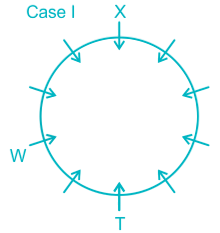

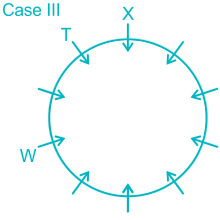
3) Neither U nor X is an immediate neighbour of T. So Case III gets eliminated.
4) As many persons sit between X and T as between U and P, when counted from the right of both X and U.
The possibilities are –
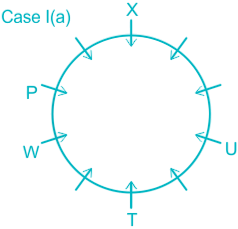
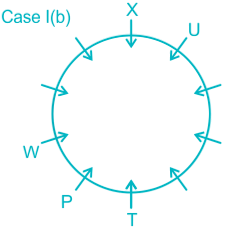
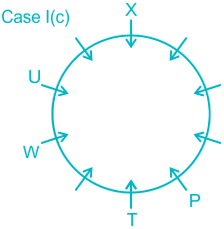
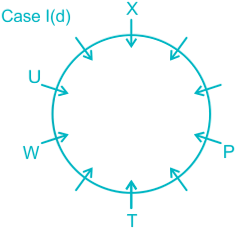

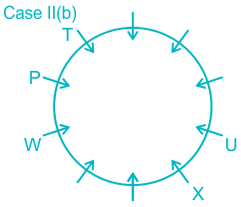
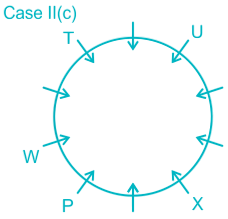

5) O sits third to the right of P. This is not possible in Case I (a), Case I (d) and Case II (a) so these cases get eliminated.
6) X is not an immediate neighbour of O. This is not possible in Case I (c), Case II (b) and Case II (c) so these cases get eliminated.

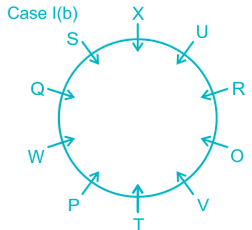
7) Both V and O sit adjacent to each other. This is not possible in Case II (d) so it gets eliminated.
8) V sits second to the left of R.
9) One person sits between S and the one who faces R.
Thus, the final arrangement is –

Only in QTU and XPV, the first person sits exactly between the third and the second person.
Hence, the correct answer is Only I and III.
79. Direction: Study the following information carefully and answer the questions given below:
Ten people viz. O, P, Q, R, S, T, U, V, W, and X are seated around the circular table to play ‘Spin the bottle’ such that all of them are facing towards the center, but not necessarily in the same order.
T sits third from the one who faces toward W. Two persons sit between W and X. Neither U nor X is an immediate neighbour of T. As many persons sit between X and T as between U and P, when counted from the right of both X and U. O sits third to the right of P. X is not an immediate neighbour of O. V sits second to the left of R. Both V and O sit adjacent to each other. One person sits between S and the one who faces R.
Question:
Four of the following five are alike in a certain way and hence form the group. Which of the following one doesn’t belong to that group?
A. PO
B. RS
C. QT
D. VU
E. SW
Solution
Given:
Ten people – O, P, Q, R, S, T, U, V, W, and X are seated around the circular table.
All of them are facing toward the center.
Now,
1) T sits third from the one who faces toward W.
2) Two persons sit between W and X.
The possibilities are –

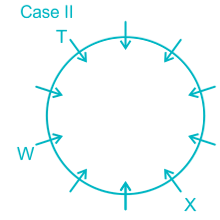

3) Neither U nor X is an immediate neighbour of T. So Case III gets eliminated.
4) As many persons sit between X and T as between U and P, when counted from the right of both X and U.
The possibilities are –

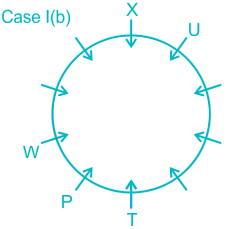
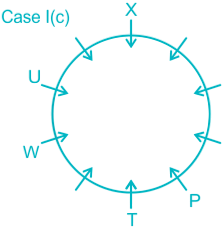


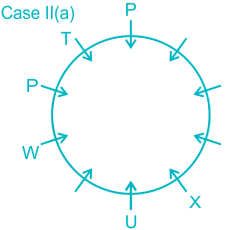
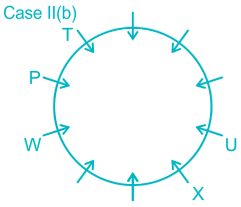

5) O sits third to the right of P. This is not possible in Case I (a), Case I (d) and Case II (a) so these cases get eliminated.
6) X is not an immediate neighbour of O. This is not possible in Case I (c), Case II (b) and Case II (c) so these cases get eliminated.
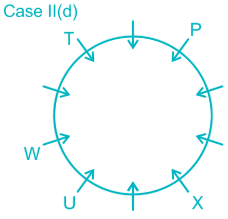
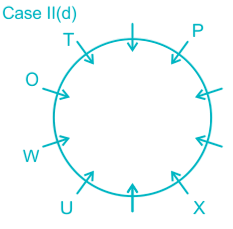
7) Both V and O sit adjacent to each other. This is not possible in Case II (d) so it gets eliminated.
8) V sits second to the left of R.
9) One person sits between S and the one who faces R.
Thus, the final arrangement is –
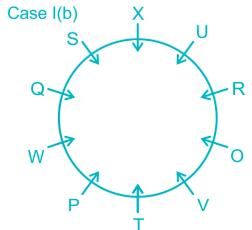
All except SW, have two persons between them when counted from the right of the first person.
Hence, the correct answer is SW.
80. Direction: Study the following information carefully and answer the questions given below:
Ten people viz. O, P, Q, R, S, T, U, V, W, and X are seated around the circular table to play ‘Spin the bottle’ such that all of them are facing towards the center, but not necessarily in the same order.
T sits third from the one who faces toward W. Two persons sit between W and X. Neither U nor X is an immediate neighbour of T. As many persons sit between X and T as between U and P, when counted from the right of both X and U. O sits third to the right of P. X is not an immediate neighbour of O. V sits second to the left of R. Both V and O sit adjacent to each other. One person sits between S and the one who faces R.
Question:
Which of the following statement is/are true with respect to V?
I. Both T and O are immediate neighbours of V.
II. V faces the one who sits second to the left of W.
III. Four persons sit between V and the one who sits to the immediate left of Q.
A. Only II
B. Only I
C. Both II and III
D. All are true
E. None is true
Solution
Given:
Ten people – O, P, Q, R, S, T, U, V, W, and X are seated around the circular table.
All of them are facing toward the center.
Now,
1) T sits third from the one who faces toward W.
2) Two persons sit between W and X.
The possibilities are –
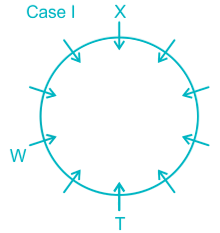
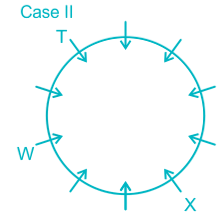
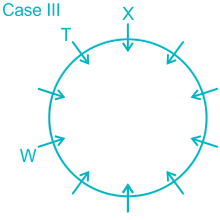
3) Neither U nor X is an immediate neighbour of T. So Case III gets eliminated.
4) As many persons sit between X and T as between U and P, when counted from the right of both X and U.
The possibilities are –
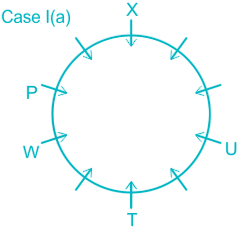

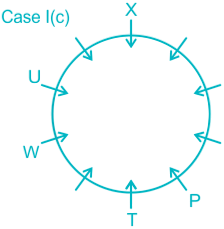
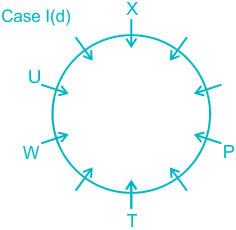


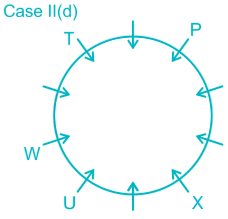

5) O sits third to the right of P. This is not possible in Case I (a), Case I (d) and Case II (a) so these cases get eliminated.
6) X is not an immediate neighbour of O. This is not possible in Case I (c), Case II (b) and Case II (c) so these cases get eliminated.


7) Both V and O sit adjacent to each other. This is not possible in Case II (d) so it gets eliminated.
8) V sits second to the left of R.
9) One person sits between S and the one who faces R.
Thus, the final arrangement is –

All the given statements I, II and III are true.
Hence, the correct answer is All are true.
81. Direction: Study the following information carefully and answer the questions given below:
Ten people viz. O, P, Q, R, S, T, U, V, W, and X are seated around the circular table to play ‘Spin the bottle’ such that all of them are facing towards the center, but not necessarily in the same order.
T sits third from the one who faces toward W. Two persons sit between W and X. Neither U nor X is an immediate neighbour of T. As many persons sit between X and T as between U and P, when counted from the right of both X and U. O sits third to the right of P. X is not an immediate neighbour of O. V sits second to the left of R. Both V and O sit adjacent to each other. One person sits between S and the one who faces R.
Question:
Who among the following person sits fourth to the right of the one who faces towards S?
A. The one who sits third to the right of Q.
B. The one who sits second to the left of O.
C. The one who sits exactly opposite to W.
D. The one who sits second to the left of Q.
E. The one who sits second to the right of O.
Solution
Given:
Ten people – O, P, Q, R, S, T, U, V, W, and X are seated around the circular table.
All of them are facing toward the center.
Now,
1) T sits third from the one who faces toward W.
2) Two persons sit between W and X.
The possibilities are –


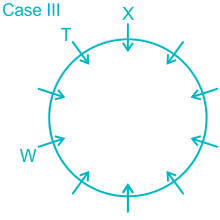
3) Neither U nor X is an immediate neighbour of T. So Case III gets eliminated.
4) As many persons sit between X and T as between U and P, when counted from the right of both X and U.
The possibilities are –

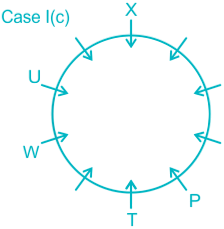
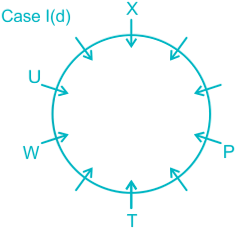
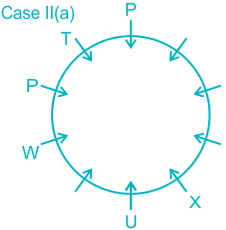
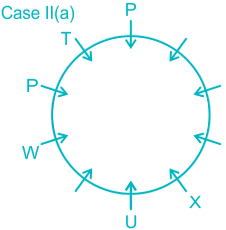
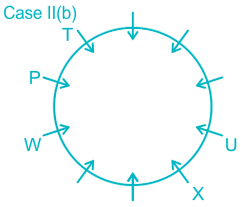

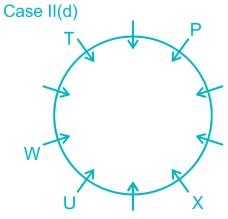
5) O sits third to the right of P. This is not possible in Case I (a), Case I (d) and Case II (a) so these cases get eliminated.
6) X is not an immediate neighbour of O. This is not possible in Case I (c), Case II (b) and Case II (c) so these cases get eliminated.
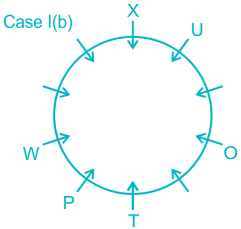
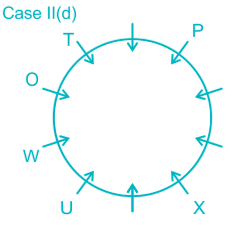
7) Both V and O sit adjacent to each other. This is not possible in Case II (d) so it gets eliminated.
8) V sits second to the left of R.
9) One person sits between S and the one who faces R.
Thus, the final arrangement is –
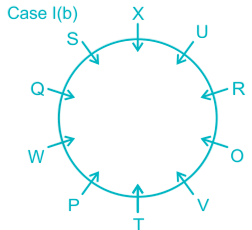
X sits fourth to the right of the one who faces toward S.
X sits second to the left of Q.
Hence, the correct answer is The one who sits second to the left of Q.
82. Direction: Study the following information carefully and answer the questions given below:
Ten people viz. O, P, Q, R, S, T, U, V, W, and X are seated around the circular table to play ‘Spin the bottle’ such that all of them are facing towards the center, but not necessarily in the same order.
T sits third from the one who faces toward W. Two persons sit between W and X. Neither U nor X is an immediate neighbour of T. As many persons sit between X and T as between U and P, when counted from the right of both X and U. O sits third to the right of P. X is not an immediate neighbour of O. V sits second to the left of R. Both V and O sit adjacent to each other. One person sits between S and the one who faces R.
Question:
Who among the following person sits fifth to the left of O?
A. R
B. T
C. U
D. Q
E. S
Solution
Given:
Ten people – O, P, Q, R, S, T, U, V, W, and X are seated around the circular table.
All of them are facing toward the center.
Now,
1) T sits third from the one who faces toward W.
2) Two persons sit between W and X.
The possibilities are –



3) Neither U nor X is an immediate neighbour of T. So Case III gets eliminated.
4) As many persons sit between X and T as between U and P, when counted from the right of both X and U.
The possibilities are –
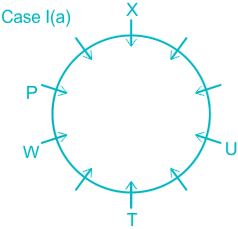
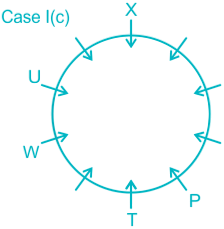
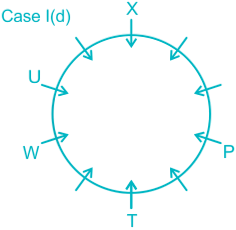
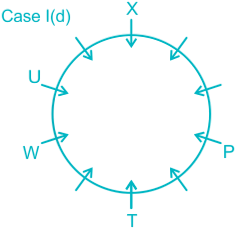
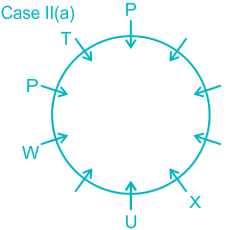

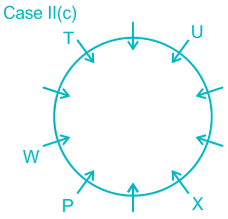

5) O sits third to the right of P. This is not possible in Case I (a), Case I (d) and Case II (a) so these cases get eliminated.
6) X is not an immediate neighbour of O. This is not possible in Case I (c), Case II (b) and Case II (c) so these cases get eliminated.
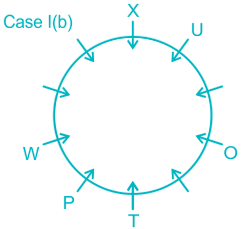
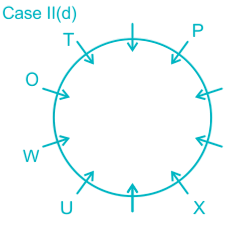
7) Both V and O sit adjacent to each other. This is not possible in Case II (d) so it gets eliminated.
8) V sits second to the left of R.
9) One person sits between S and the one who faces R.
Thus, the final arrangement is –
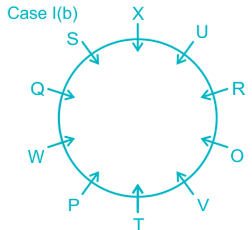
Q sits fifth to the left of O.
Hence, the correct answer is Q.
83. Direction: Study the following information carefully and answer the questions given below.
Anitha walks 12m north from point B to reach point G. He takes a left turn and walks 11m to reach point E. Now, Varun walks 5m north from point T to reach point V. Point T is 11m either towards the east or towards the west from point B. Again, Varun turns to his right and walks 6m to reach point I. Also, Anitha turns to his left from point E and reaches point F after walking 7m. F is in the west direction from V. From F Anitha moves 5m south direction and reaches point Z. Varun moves 7m north from point I and reaches point X. Varun then moves to the left and reaches point G.
Question:
What is the total distance travelled by Varun?
A. 30 meters
B. 35 meters
C. 12 meters
D. 33 meters
E. 40 meters
Solution
The Direction diagram is as follows
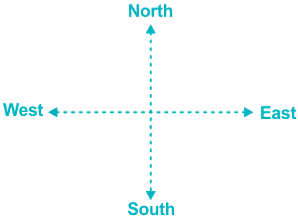
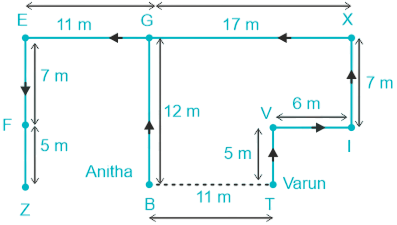
From the diagram, we get the total distance traveled by Varun is VT + VI + IX + XG which is equal to 35 meters.
84. Direction: Study the following information carefully and answer the questions given below.
Anitha walks 12m north from point B to reach point G. He takes a left turn and walks 11m to reach point E. Now, Varun walks 5m north from point T to reach point V. Point T is 11m either towards the east or towards the west from point B. Again, Varun turns to his right and walks 6m to reach point I. Also, Anitha turns to his left from point E and reaches point F after walking 7m. F is in the west direction from V. From F Anitha moves 5m south direction and reaches point Z. Varun moves 7m north from point I and reaches point X. Varun then moves to the left and reaches point G.
Question:
What is the shortest distance between point E and point B?
A. √80 meter
B. √185 meter
C. √165 meter
D. √266 meter
E. √265 meter
Solution
The Direction diagram is as follows
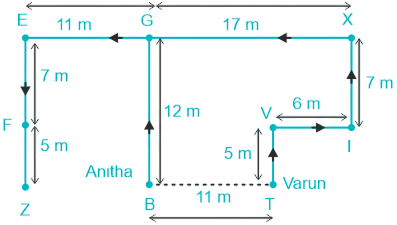
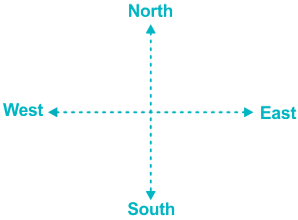
From the diagram, we get a right-angled triangle EZB
So we can use the Pythagorean theorem here
(Shortest distance, EB)² = (ZB)² + (EZ)²
(EB)² = 11² + 12²
(EB)² = 121 + 144
(EB)² = 265
Shortest distance, EB = √265 meters
Hence the shortest distance between point E and point B is √265 meters.
85. Direction: Study the following information carefully and answer the questions given below.
Anitha walks 12m north from point B to reach point G. He takes a left turn and walks 11m to reach point E. Now, Varun walks 5m north from point T to reach point V. Point T is 11m either towards the east or towards the west from point B. Again, Varun turns to his right and walks 6m to reach point I. Also, Anitha turns to his left from point E and reaches point F after walking 7m. F is in the west direction from V. From F Anitha moves 5m south direction and reaches point Z. Varun moves 7m north from point I and reaches point X. Varun then moves to the left and reaches point G.
Question:
At what minimum distance is point I from point T and in which direction?
A. √61 meters, North-East
B. √61 meters, North-West
C. √71 meters, South-West
D. √80 meters, South
E. 17 meters, North
Solution
The Direction diagram is as follows
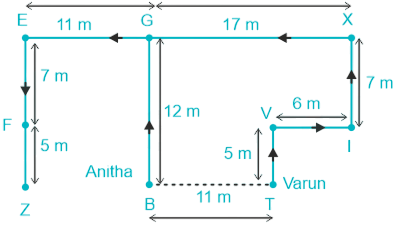
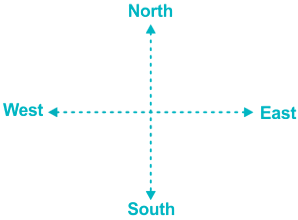
From the diagram, we get a right-angled triangle IVT
So we can use the Pythagorean theorem here
(Shortest distance, TI)² = (VI)² + (TV)²
(TI)² = 6² + 5²
(TI)² = 36 + 25
(TI)² = 61
Shortest distance, TI = √61 meters
Hence the shortest distance between point E and point B is √61 meters and point I is in the North-East direction to point T.
86. Direction: In each question below, there are three statements followed by two conclusions numbered I and II. Assume the statements are true, even if they seem to contradict known facts. Read both conclusions and decide which one(s) logically follow based only on the statements.
Statements:
All doubts are thoughts.
No thought is an eternal.
Maximum beliefs are thoughts.
Conclusions:
I. No doubt is eternal.
II. Some beliefs are doubts.
A. Only I follows
B. Only II follows
C. Both I and II follows
D. Either I or II follow
E. Neither I nor II follow
Solution
The least possible Venn Diagram for the given statements will be as follows,

I. No doubt is eternal → Ture (since no thought is an eternal and all doubts are thoughts).
II. Some beliefs are doubts → False (Because there is no direct relation given between beliefs and doubts, hence, false).Hence, only I follow.
87. Directions: In the question below are given three statements followed by two conclusions I and II. You have to take the given statements to be true even if they seem to be at variance from commonly known facts. Read all the conclusions and then decide which of the given conclusions logically follows from the given statements disregarding commonly known facts.
Statements:
All sandals are shoes. Only a few shoes are flats. All flats are heels.
Conclusions:
I. Some sandals are flats.
II. All shoes can be flats is possible.
A. Only conclusion I follows
B. Only conclusion II follows
C. Both conclusion I and II follows
D. Neither conclusion I nor II follows
E. Either conclusion I or II follows
Solution
Given:
Statements:
All sandals are shoes.
Only a few shoes are flats.
All flats are heels.
The least possible Venn diagram for the given statement is:

Conclusions:
I. Some sandals are flats → False (Because there is no direct relation given between sandals and flats, so it can be possible but not definitely true.)
II. All shoes can be flats is possible → False (Because it is given that only a few shoes are flats which means the rest of the shoes are not flats.)
So, none of the conclusions follows.
Hence, the correct answer is “Option 4”.
88. If 4 is subtracted from all the digits greater than 6 and 3 is added to all the digits less than 6 in the number ‘14579283’, then how many digits are repeated in the newly formed number?
A. Three
B. Two
C. One
D. Four
E. None
Solution
Given: The number is ‘14579283’
Mathematical Operation: 4 is subtracted from all the digits greater than 6 and 3 is added to all the digits less than 6.
After following the operation given in the question, we get the newly the formed number as follows:
| Before | 1 | 4 | 5 | 7 | 9 | 2 | 8 | 3 |
| Addition andSubtraction | <6 +3 | <6 +3 | <6 +3 | >6 -4 | >6 -4 | <6 +3 | >6 -4 | <6 +3 |
| After | 4 | 7 | 8 | 3 | 5 | 5 | 4 | 6 |
Repeated digits are 4, and 5Hence, two digits are repeated in the newly formed number.
89. Directions: Study the following information carefully and answer the questions given below:
Eight persons A, C, D, F, G, H, J, and K live (but not necessarily in the given order) in a 56-floor building but only on the floors which are multiple of 7. (For example – 7, 14, 21, and so on). Floors are arranged from bottom to top in increasing order.
The number of persons living between D and H is equal to K and J. G lives on the floor which is a multiple of 3. The sum of floors of J and H is equal to the floor of F. D lives on the floor which is a perfect square. The difference between the number of floors between A and C is divisible by the floor number of C. The number of floor on which J lives is one-fourth of the total floors in the building.
Question:
What is the difference between the floors of G and J?
A. 7
B. 14
C. 21
D. 28
E. More than 28
Solution
Given:
Eight persons – A, C, D, F, G, H, J and K
Lives in a 56-floor building but only on the floors which are multiple of 7 from bottom to top in increasing order.
So, the floor numbers on which the eight persons live are 7, 14, 21, 28, 35, 42, 49, and 56 from bottom to top.
Now,
1) D lives on the floor which is a perfect square. The only perfect square is 49.
2) The number of floor on which J lives is one-fourth of the total floors in the building. 564564 = 14.
3) G lives on the floor which is a multiple of 3. The numbers which are multiple of both 7 and 3 up to 56 are 21 and 42.
| Floors | Case I | Case II |
| 56 | ||
| 49 | D | D |
| 42 | G | |
| 35 | ||
| 28 | ||
| 21 | G | |
| 14 | J | J |
| 7 |
4) The sum of floors of J and H is equal to the floor of F.
The possible floors for H and F in Case I can be 14 (J) + 28 (H) = 42 (F) or 14 (J) + 42 (H) = 56 (F).
The possible floors for H and F in Case II can be 14 (J) + 7 (H) = 21 (F) or 14 (J) + 21 (H) = 35 (F).
| Floors | Case I (a) | Case I (b) | Case II (a) | Case II (b) |
| 56 | F | |||
| 49 | D | D | D | D |
| 42 | F | H | G | G |
| 35 | F | |||
| 28 | H | |||
| 21 | G | G | F | H |
| 14 | J | J | J | J |
| 7 | H |
5) The number of persons living between D and H is equal to K and J.
| Floors | Case I (a) | Case I (b) | Case II (a) |
| 56 | F | K | |
| 49 | D | D | D |
| 42 | F | H | G |
| 35 | K | ||
| 28 | H | ||
| 21 | G | G | F |
| 14 | J | J | J |
| 7 | K | H |
6) The difference between the number of floors between A and C is divisible by the floor number of C. This is possible only in Case I (a) as 56 (A) – 7 (C) = 49 which is completely divisible by the floor number of C.
Thus, the final arrangement is –
| Floors | Case I (a) |
| 56 | A |
| 49 | D |
| 42 | F |
| 35 | K |
| 28 | H |
| 21 | G |
| 14 | J |
| 7 | C |
G – J = 21 – 14 = 7.
Hence, the correct answer is 28.
90. Directions: Study the following information carefully and answer the questions given below:
Eight persons A, C, D, F, G, H, J, and K live (but not necessarily in the given order) in a 56-floor building but only on the floors which are multiple of 7. (For example – 7, 14, 21, and so on). Floors are arranged from bottom to top in increasing order.
The number of persons living between D and H is equal to K and J. G lives on the floor which is a multiple of 3. The sum of floors of J and H is equal to the floor of F. D lives on the floor which is a perfect square. The difference between the number of floors between A and C is divisible by the floor number of C. The number of floor on which J lives is one-fourth of the total floors in the building.
Question:
Which of the following is not correct?
A. A lives on the topmost floor.
B. D lives on an odd-numbered floor.
C. One person lives between F and H.
D. J lives on the 14h floor.
E. C lives above K.
Solution
Given:
Eight persons – A, C, D, F, G, H, J and K
Lives in a 56-floor building but only on the floors which are multiple of 7 from bottom to top in increasing order.
So, the floor numbers on which the eight persons live are 7, 14, 21, 28, 35, 42, 49, and 56 from bottom to top.
Now,
1) D lives on the floor which is a perfect square. The only perfect square is 49.
2) The number of floor on which J lives is one-fourth of the total floors in the building. 564564 = 14.
3) G lives on the floor which is a multiple of 3. The numbers which are multiple of both 7 and 3 up to 56 are 21 and 42.
| Floors | Case I | Case II |
| 56 | ||
| 49 | D | D |
| 42 | G | |
| 35 | ||
| 28 | ||
| 21 | G | |
| 14 | J | J |
| 7 |
4) The sum of floors of J and H is equal to the floor of F.
The possible floors for H and F in Case I can be 14 (J) + 28 (H) = 42 (F) or 14 (J) + 42 (H) = 56 (F).
The possible floors for H and F in Case II can be 14 (J) + 7 (H) = 21 (F) or 14 (J) + 21 (H) = 35 (F).
| Floors | Case I (a) | Case I (b) | Case II (a) | Case II (b) |
| 56 | F | |||
| 49 | D | D | D | D |
| 42 | F | H | G | G |
| 35 | F | |||
| 28 | H | |||
| 21 | G | G | F | H |
| 14 | J | J | J | J |
| 7 | H |
5) The number of persons living between D and H is equal to K and J.
| Floors | Case I (a) | Case I (b) | Case II (a) |
| 56 | F | K | |
| 49 | D | D | D |
| 42 | F | H | G |
| 35 | K | ||
| 28 | H | ||
| 21 | G | G | F |
| 14 | J | J | J |
| 7 | K | H |
6) The difference between the number of floors between A and C is divisible by the floor number of C. This is possible only in Case I (a) as 56 (A) – 7 (C) = 49 which is completely divisible by the floor number of C.
Thus, the final arrangement is –
| Floors | Case I (a) |
| 56 | A |
| 49 | D |
| 42 | F |
| 35 | K |
| 28 | H |
| 21 | G |
| 14 | J |
| 7 | C |
K lives above C.
Hence, the correct answer is C lives above K.
91. Directions: Study the following information carefully and answer the questions given below:
Eight persons A, C, D, F, G, H, J, and K live (but not necessarily in the given order) in a 56-floor building but only on the floors which are multiple of 7. (For example – 7, 14, 21, and so on). Floors are arranged from bottom to top in increasing order.
The number of persons living between D and H is equal to K and J. G lives on the floor which is a multiple of 3. The sum of floors of J and H is equal to the floor of F. D lives on the floor which is a perfect square. The difference between the number of floors between A and C is divisible by the floor number of C. The number of floor on which J lives is one-fourth of the total floors in the building.
Question:
If A is related to F, K is related to G, in the same manner, ________ is related to H?
A. D
B. H
C. J
D. C
E. F
Solution
Given:
Eight persons – A, C, D, F, G, H, J and K
Lives in a 56-floor building but only on the floors which are multiple of 7 from bottom to top in increasing order.
So, the floor numbers on which the eight persons live are 7, 14, 21, 28, 35, 42, 49, and 56 from bottom to top.
Now,
1) D lives on the floor which is a perfect square. The only perfect square is 49.
2) The number of floor on which J lives is one-fourth of the total floors in the building. 564564 = 14.
3) G lives on the floor which is a multiple of 3. The numbers which are multiple of both 7 and 3 up to 56 are 21 and 42.
| Floors | Case I | Case II |
| 56 | ||
| 49 | D | D |
| 42 | G | |
| 35 | ||
| 28 | ||
| 21 | G | |
| 14 | J | J |
| 7 |
4) The sum of floors of J and H is equal to the floor of F.
The possible floors for H and F in Case I can be 14 (J) + 28 (H) = 42 (F) or 14 (J) + 42 (H) = 56 (F).
The possible floors for H and F in Case II can be 14 (J) + 7 (H) = 21 (F) or 14 (J) + 21 (H) = 35 (F).
| Floors | Case I (a) | Case I (b) | Case II (a) | Case II (b) |
| 56 | F | |||
| 49 | D | D | D | D |
| 42 | F | H | G | G |
| 35 | F | |||
| 28 | H | |||
| 21 | G | G | F | H |
| 14 | J | J | J | J |
| 7 | H |
5) The number of persons living between D and H is equal to K and J.
| Floors | Case I (a) | Case I (b) | Case II (a) |
| 56 | F | K | |
| 49 | D | D | D |
| 42 | F | H | G |
| 35 | K | ||
| 28 | H | ||
| 21 | G | G | F |
| 14 | J | J | J |
| 7 | K | H |
6) The difference between the number of floors between A and C is divisible by the floor number of C. This is possible only in Case I (a) as 56 (A) – 7 (C) = 49 which is completely divisible by the floor number of C.
Thus, the final arrangement is –
| Floors | Case I (a) |
| 56 | A |
| 49 | D |
| 42 | F |
| 35 | K |
| 28 | H |
| 21 | G |
| 14 | J |
| 7 | C |
F is related to H in the given manner.
Hence, the correct answer is F.
92. Directions: Study the following information carefully and answer the questions given below:
Eight persons A, C, D, F, G, H, J, and K live (but not necessarily in the given order) in a 56-floor building but only on the floors which are multiple of 7. (For example – 7, 14, 21, and so on). Floors are arranged from bottom to top in increasing order.
The number of persons living between D and H is equal to K and J. G lives on the floor which is a multiple of 3. The sum of floors of J and H is equal to the floor of F. D lives on the floor which is a perfect square. The difference between the number of floors between A and C is divisible by the floor number of C. The number of floor on which J lives is one-fourth of the total floors in the building.
Question:
Who lives on the 7th floor?
A. A
B. F
C. C
D. H
E. J
Solution
Given:
Eight persons – A, C, D, F, G, H, J and K
Lives in a 56-floor building but only on the floors which are multiple of 7 from bottom to top in increasing order.
So, the floor numbers on which the eight persons live are 7, 14, 21, 28, 35, 42, 49, and 56 from bottom to top.
Now,
1) D lives on the floor which is a perfect square. The only perfect square is 49.
2) The number of floor on which J lives is one-fourth of the total floors in the building. 564564 = 14.
3) G lives on the floor which is a multiple of 3. The numbers which are multiple of both 7 and 3 up to 56 are 21 and 42.
| Floors | Case I | Case II |
| 56 | ||
| 49 | D | D |
| 42 | G | |
| 35 | ||
| 28 | ||
| 21 | G | |
| 14 | J | J |
| 7 |
4) The sum of floors of J and H is equal to the floor of F.
The possible floors for H and F in Case I can be 14 (J) + 28 (H) = 42 (F) or 14 (J) + 42 (H) = 56 (F).
The possible floors for H and F in Case II can be 14 (J) + 7 (H) = 21 (F) or 14 (J) + 21 (H) = 35 (F).
| Floors | Case I (a) | Case I (b) | Case II (a) | Case II (b) |
| 56 | F | |||
| 49 | D | D | D | D |
| 42 | F | H | G | G |
| 35 | F | |||
| 28 | H | |||
| 21 | G | G | F | H |
| 14 | J | J | J | J |
| 7 | H |
5) The number of persons living between D and H is equal to K and J.
| Floors | Case I (a) | Case I (b) | Case II (a) |
| 56 | F | K | |
| 49 | D | D | D |
| 42 | F | H | G |
| 35 | K | ||
| 28 | H | ||
| 21 | G | G | F |
| 14 | J | J | J |
| 7 | K | H |
6) The difference between the number of floors between A and C is divisible by the floor number of C. This is possible only in Case I (a) as 56 (A) – 7 (C) = 49 which is completely divisible by the floor number of C.
Thus, the final arrangement is –
| Floors | Case I (a) |
| 56 | A |
| 49 | D |
| 42 | F |
| 35 | K |
| 28 | H |
| 21 | G |
| 14 | J |
| 7 | C |
C lives on the 7th floor.
Hence, the correct answer is C.
93. Directions: Study the following information carefully and answer the questions given below:
Eight persons A, C, D, F, G, H, J, and K live (but not necessarily in the given order) in a 56-floor building but only on the floors which are multiple of 7. (For example – 7, 14, 21, and so on). Floors are arranged from bottom to top in increasing order.
The number of persons living between D and H is equal to K and J. G lives on the floor which is a multiple of 3. The sum of floors of J and H is equal to the floor of F. D lives on the floor which is a perfect square. The difference between the number of floors between A and C is divisible by the floor number of C. The number of floor on which J lives is one-fourth of the total floors in the building.
Question:
How many persons live between K and D?
A. Four
B. Two
C. One
D. Five
E. None of these
Solution
Given:
Eight persons – A, C, D, F, G, H, J and K
Lives in a 56-floor building but only on the floors which are multiple of 7 from bottom to top in increasing order.
So, the floor numbers on which the eight persons live are 7, 14, 21, 28, 35, 42, 49, and 56 from bottom to top.
Now,
1) D lives on the floor which is a perfect square. The only perfect square is 49.
2) The number of floor on which J lives is one-fourth of the total floors in the building. 564564 = 14.
3) G lives on the floor which is a multiple of 3. The numbers which are multiple of both 7 and 3 up to 56 are 21 and 42.
| Floors | Case I | Case II |
| 56 | ||
| 49 | D | D |
| 42 | G | |
| 35 | ||
| 28 | ||
| 21 | G | |
| 14 | J | J |
| 7 |
4) The sum of floors of J and H is equal to the floor of F.
The possible floors for H and F in Case I can be 14 (J) + 28 (H) = 42 (F) or 14 (J) + 42 (H) = 56 (F).
The possible floors for H and F in Case II can be 14 (J) + 7 (H) = 21 (F) or 14 (J) + 21 (H) = 35 (F).
| Floors | Case I (a) | Case I (b) | Case II (a) | Case II (b) |
| 56 | F | |||
| 49 | D | D | D | D |
| 42 | F | H | G | G |
| 35 | F | |||
| 28 | H | |||
| 21 | G | G | F | H |
| 14 | J | J | J | J |
| 7 | H |
5) The number of persons living between D and H is equal to K and J.
| Floors | Case I (a) | Case I (b) | Case II (a) |
| 56 | F | K | |
| 49 | D | D | D |
| 42 | F | H | G |
| 35 | K | ||
| 28 | H | ||
| 21 | G | G | F |
| 14 | J | J | J |
| 7 | K | H |
6) The difference between the number of floors between A and C is divisible by the floor number of C. This is possible only in Case I (a) as 56 (A) – 7 (C) = 49 which is completely divisible by the floor number of C.
Thus, the final arrangement is –
| Floors | Case I (a) |
| 56 | A |
| 49 | D |
| 42 | F |
| 35 | K |
| 28 | H |
| 21 | G |
| 14 | J |
| 7 | C |
One person lives between K and D.
Hence, the correct answer is One.
94. Each vowel in the word ‘SUBSTANCES’ is replaced by the previous letter and each consonant are changed to their next letter as per the English alphabet series. Which of the following letter will be third to the left of U after rearrangement?
A. T
B. C
C. U
D. O
E. D
Solution
Given word: SUBSTANCES
Vowels in the word: U A E
After replacing the vowel with previous letter: T Z D
Consonants in the word: S B S T N C S
After replacing consonant with the next letter: T C T U O D T
After replacing all the letters according to the condition, we get: T T C T U Z O D D T
Hence, T is third to the left of U.
95. Directions: Read the given information carefully and answer the following questions.
A Certain number of persons is sitting in a row facing north. Two persons are sitting between S and O. Three persons are sitting between O and R. P is sitting left of R. There are as many persons in between M and N as in between Q and N. Q is sitting second from one of the extreme end. S is sitting at one of the extreme end. M is third to the left of P. One person is sitting between R and P. M is not an immediate neighbor of O and R. T is the immediate right of O. The number of persons sitting between P and O is one more than the number of persons sitting between N and P.
Question:
Which of the following person is sitting at right extreme end?
A. M
B. N
C. O
D. S
E. P
Solution
All the persons are facing north.
Information about the number of persons is not given.
1) S is sitting at one of the extreme ends. Two persons are sitting between S and O. Three persons are between O and R.


2) One person is sitting between R and P. P is sitting left of R. T is immediate right of O. M is third to the left of P.



3) M is not an immediate neighbour of O and R.
M is sitting immediate right of O. So, Case 2 is eliminated.
4) The number of persons sitting between P and O is one more than the number of persons sitting between N and P.
Five persons are sitting between P and O. So, according to the condition given four persons would be sitting between N and P.
5) There are as many persons between M and N as between Q and N.
If we place N to the right of P. Then we cannot place Q in this arrangement according to the given condition. So, we will place N towards the left of P.
The final arrangement is:

Hence, S sits at the right extreme end.
96. Directions: Read the given information carefully and answer the following questions.
A Certain number of persons is sitting in a row facing north. Two persons are sitting between S and O. Three persons are sitting between O and R. P is sitting left of R. There are as many persons in between M and N as in between Q and N. Q is sitting second from one of the extreme end. S is sitting at one of the extreme end. M is third to the left of P. One person is sitting between R and P. M is not an immediate neighbor of O and R. T is the immediate right of O. The number of persons sitting between P and O is one more than the number of persons sitting between N and P.
Question:
Who is sitting fifth to the left of the person sitting second right of P?
A. T
B. R
C. N
D. S
E. M
Solution
All the persons are facing north.
Information about the number of persons is not given.
1) S is sitting at one of the extreme ends. Two persons are sitting between S and O. Three persons are between O and R.


2) One person is sitting between R and P. P is sitting left of R. T is immediate right of O. M is third to the left of P.



3) M is not an immediate neighbour of O and R.
M is sitting immediate right of O. So, Case 2 is eliminated.
4) The number of persons sitting between P and O is one more than the number of persons sitting between N and P.
Five persons are sitting between P and O. So, according to the condition given four persons would be sitting between N and P.
5) There are as many persons between M and N as between Q and N.
If we place N to the right of P. Then we cannot place Q in this arrangement according to the given condition. So, we will place N towards the left of P.
The final arrangement is:

R is sitting second to the right of P and M is sitting fifth to the left of R. Hence, M is sitting fifth to the left of the person sitting second right of P.
97. Directions: Read the given information carefully and answer the following questions.
A Certain number of persons is sitting in a row facing north. Two persons are sitting between S and O. Three persons are sitting between O and R. P is sitting left of R. There are as many persons in between M and N as in between Q and N. Q is sitting second from one of the extreme end. S is sitting at one of the extreme end. M is third to the left of P. One person is sitting between R and P. M is not an immediate neighbor of O and R. T is the immediate right of O. The number of persons sitting between P and O is one more than the number of persons sitting between N and P.
Question:
How many persons are sitting in a row?
A. Seventeen
B. Eighteen
C. Sixteen
D. Nine
E. Ten
Solution
All the persons are facing north.
Information about the number of persons is not given.
1) S is sitting at one of the extreme ends. Two persons are sitting between S and O. Three persons are between O and R.


2) One person is sitting between R and P. P is sitting left of R. T is immediate right of O. M is third to the left of P.



3) M is not an immediate neighbour of O and R.
M is sitting immediate right of O. So, Case 2 is eliminated.
4) The number of persons sitting between P and O is one more than the number of persons sitting between N and P.
Five persons are sitting between P and O. So, according to the condition given four persons would be sitting between N and P.
5) There are as many persons between M and N as between Q and N.
If we place N to the right of P. Then we cannot place Q in this arrangement according to the given condition. So, we will place N towards the left of P.
The final arrangement is:

Hence, Eighteen persons are sitting in a row.
98. Direction: Read the following information carefully and answer the questions based on given information.
In a family of eight persons, there are three married couples present and the number of male person is more than number of female person. B is the brother – in – law of P. W is the nephew of M. R is the sister – in – law of V. L is the only son of P’s sibling. B has no sister. L is not the brother of V. There is no single parent in the family. M is the only daughter of H. P is unmarried.
Question:
Find the odd one out.
A. B
B. P
C. L
D. H
E. W
Solution

From the given information, the family members are B, P, W, M, R, V, L and H.
1) L is the only son of P’s sibling.
2) B is the brother – in – law P.
3) P is unmarried. So, P is sibling of B’s wife and L is the son of B.
4) R is the sister – in – law of V.
5) W is the nephew of M.
7) M is the only daughter of H. Since, M belongs to second generation so there is only one possibility M is the sister of L. So, V is the husband of M and R is the wife of L.
6) L is not the brother of V. Male persons are more than female persons so P is the male person.
Hence, the final arrangement is as follows

Since, all except H are male persons whereas H is the female member.
Hence, the odd one is H.
99. Direction: Read the following information carefully and answer the questions based on given information.
In a family of eight persons, there are three married couples present and the number of male person is more than number of female person. B is the brother – in – law of P. W is the nephew of M. R is the sister – in – law of V. L is the only son of P’s sibling. B has no sister. L is not the brother of V. There is no single parent in the family. M is the only daughter of H. P is unmarried.
Question:
Which of the following statement is/ are correct?
A. P is the father of M.
B. R is the daughter of L.
C. H is the father of M.
D. W is the youngest member.
E. All are correct
Solution

From the given information, the family members are B, P, W, M, R, V, L and H.
1) L is the only son of P’s sibling.
2) B is the brother – in – law P.
3) P is unmarried. So, P is sibling of B’s wife and L is the son of B.
4) R is the sister – in – law of V.
5) W is the nephew of M.
7) M is the only daughter of H. Since, M belongs to second generation so there is only one possibility M is the sister of L. So, V is the husband of M and R is the wife of L.
6) L is not the brother of V. Male persons are more than female persons so P is the male person.
Hence, the final arrangement is as follows

Since, P is the maternal uncle of M. So, statement 1 is incorrect.
R is the wife of L. So, statement 2 is incorrect.
H is the mother of M. So, statement 3 is incorrect.
W is the youngest person in the family. So, statement 4 is correct.
Hence, the correct statement is W is the youngest member.
100. Direction: Read the following information carefully and answer the questions based on given information.
In a family of eight persons, there are three married couples present and the number of male person is more than number of female person. B is the brother – in – law of P. W is the nephew of M. R is the sister – in – law of V. L is the only son of P’s sibling. B has no sister. L is not the brother of V. There is no single parent in the family. M is the only daughter of H. P is unmarried.
Question:
How is L related to B?
A. Daughter
B. Sister – in – law
C. Mother
D. Son
E. Can not be determined
Solution

From the given information, the family members are B, P, W, M, R, V, L and H.
1) L is the only son of P’s sibling.
2) B is the brother – in – law P.
3) P is unmarried. So, P is sibling of B’s wife and L is the son of B.
4) R is the sister – in – law of V.
5) W is the nephew of M.
7) M is the only daughter of H. Since, M belongs to second generation so there is only one possibility M is the sister of L. So, V is the husband of M and R is the wife of L.
6) L is not the brother of V. Male persons are more than female persons so P is the male person.
Hence, the final arrangement is as follows

Hence, L is the son of B.
